In this guide, I’m introducing you to the amazing island of Foehr, which floats in the North Sea off the coast of Germany. Wide sandy beaches, picturesque Frisian villages, an eventful history, endless bike paths, and fresh North Sea air: you’re sure to find your very own favorite spot here.
So, you’re ready to escape everyday life? Then follow me on a little trip to Foehr!
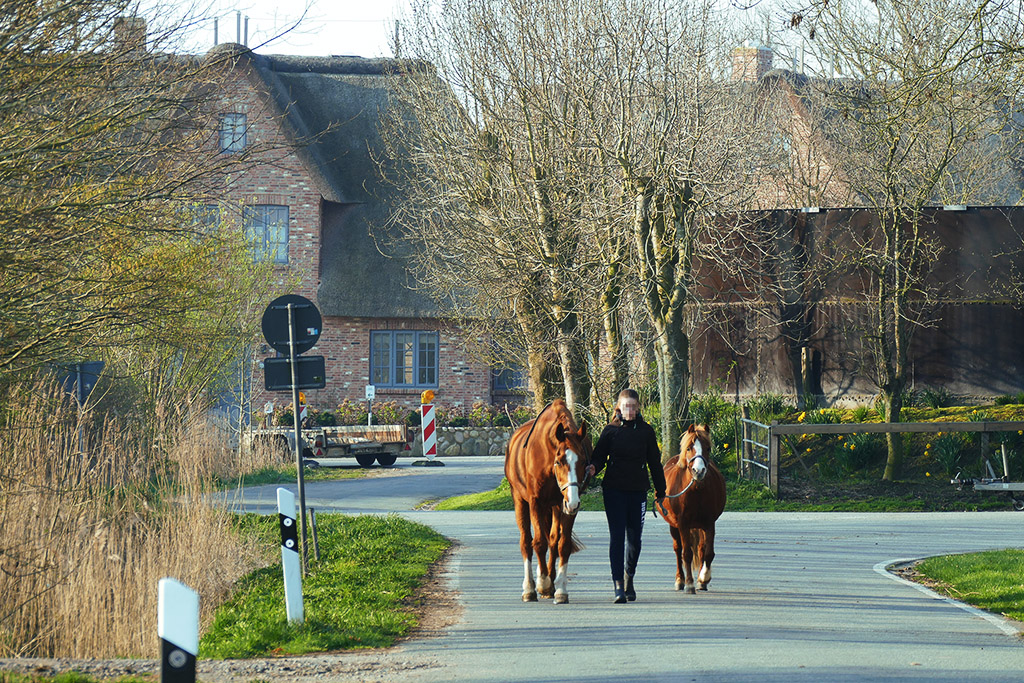
In Foehr, every village is a home. Come again: every village a home – what’s that all about?
Well, on one of Germany’s most popular holiday islands, almost every one of the 16 villages’ names ends with the suffix –um. This is the Frisian and Lower German version of heim, which translates to home. Hence, you can imagine how cozy and homey this North Frisian island is to its….homies.
The Wadden Sea
The National Park Wadden Sea stretches from the Netherlands along the German West Coast all the way up to Denmark. This makes it the world’s largest contiguous Wadden area.
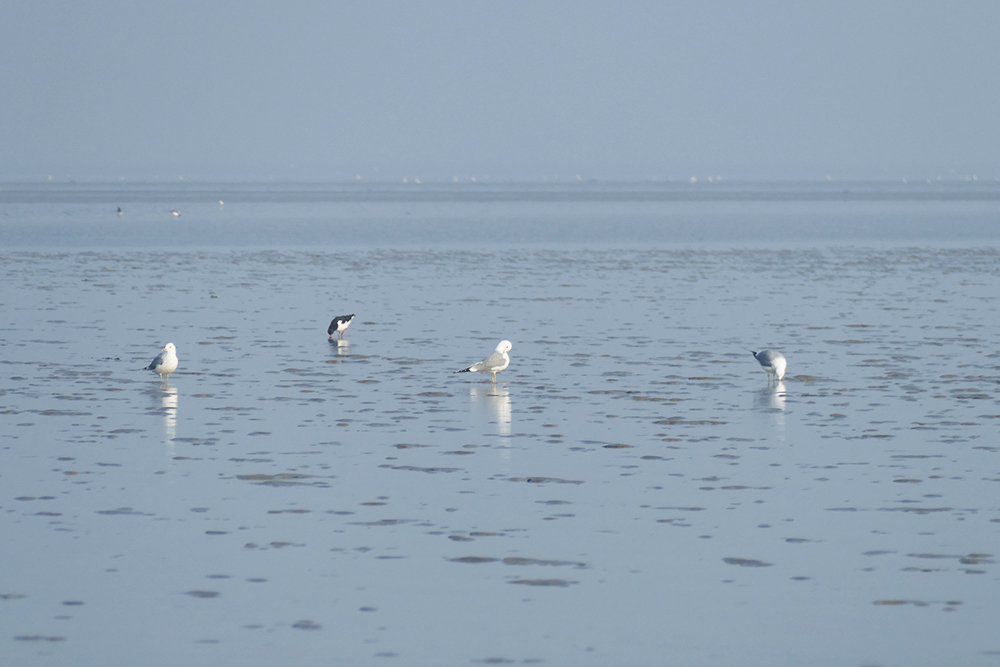
There are seven East Frisian and five North Frisian islands scattered in the German part. Föhr* is the largest and most populated island with no land connection. Therefore, going to Föhr, you have to take a ferry, which adds to the charm, obviously.
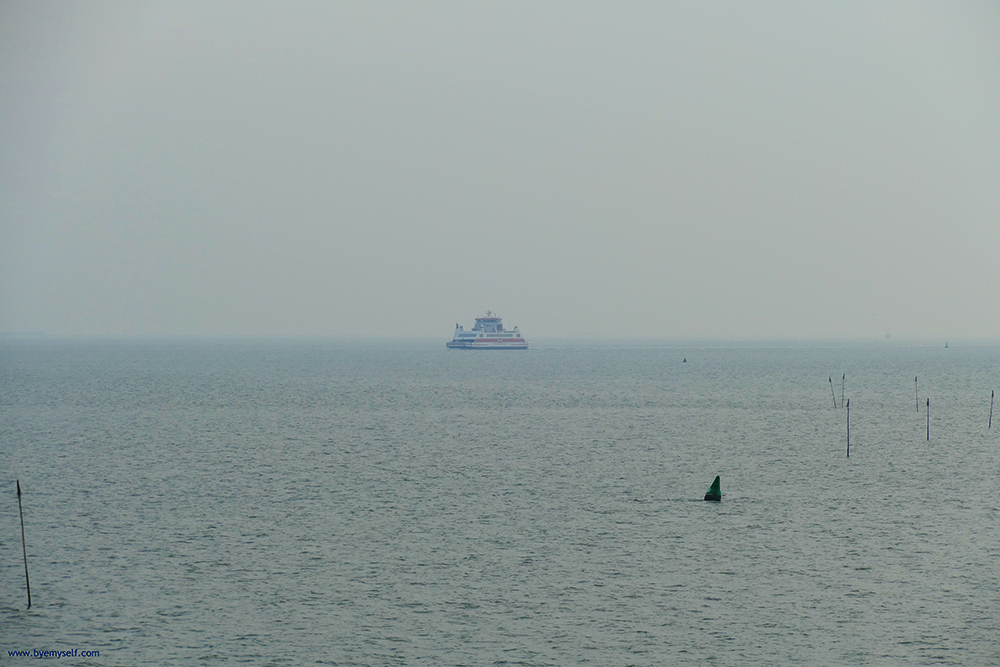
Already while crossing from Dagebüll, the small harbor on the mainland, you’ll spot some smaller isles on the horizon. These are so-called Halligs, small islets, some unpopulated, some being home to tiny communities like the nine inhabitants of Hallig Gröde, located southeast of Föhr.
By the way, I’ve introduced Borkum, one of the East Frisian islands, in another post of my series on Island Hopping in Germany.
Wyk
Wyk is the capital of the island of Föhr and, obviously, one of the exceptions to the –um-rule. More than half of Föhr’s population, which is about 8,500 people. As a matter of fact, Wyk is also the only town on the island.
Before I keep going, I’d like to emphasize that Wyk is pronounced almost like week in English. Whereby, you would replace the w with a v, so that it’s veek.
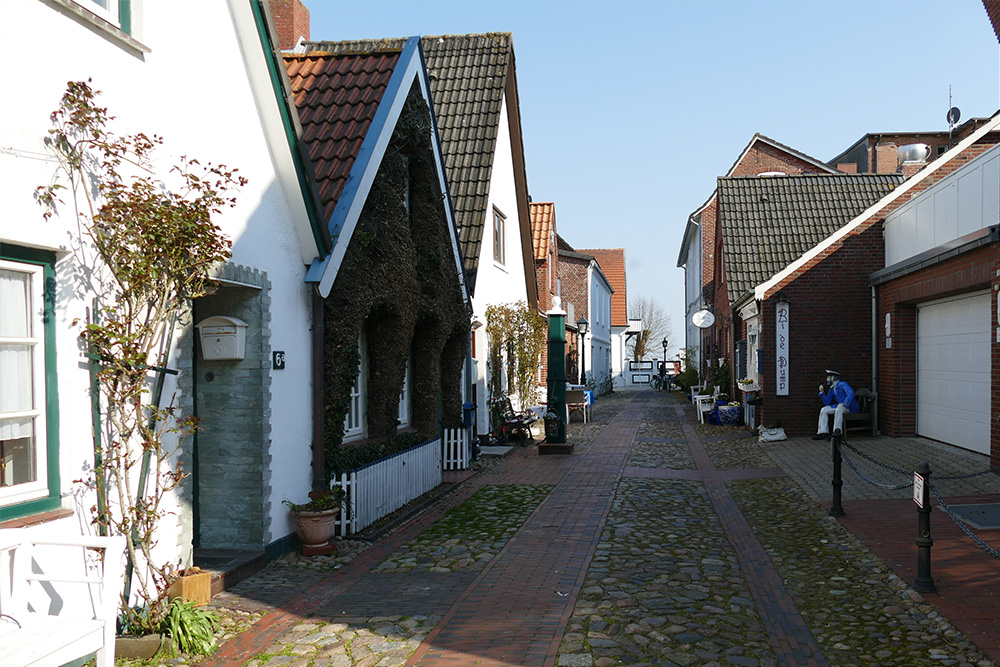
Everyone has to pay Wyk at least a short visit because there are not only shops and supermarkets, a movie theater, and a disco – yes, disco, just like back in the 1970s. There is also the small harbor from where ferries are crossing by the hour between 7 a.m. and 8 p.m.
Halligs
Also, the day trips to the Halligs around Föhr are starting from here.
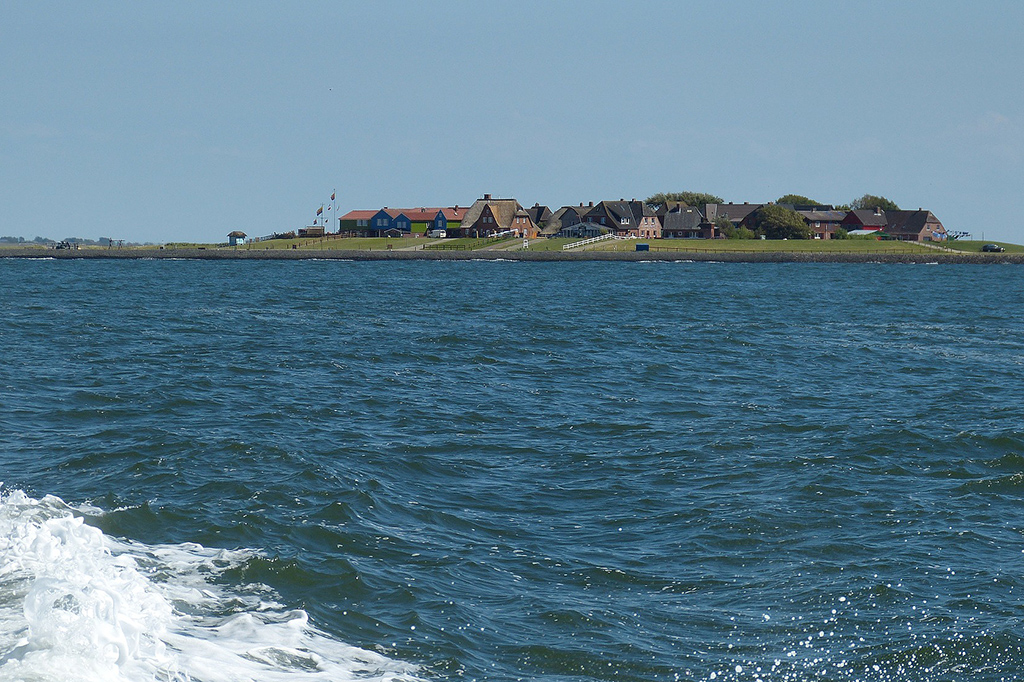
Halligs are small, undiked islets off the coast of Germany’s northernmost Federal State, Schleswig-Holstein. There are ten of them, and if you have the opportunity, it’s totally worth staying another day to enjoy a cruise to these unique, secluded places. You can visit either one of the two largest of the ten Halligs called Langeneß and Hooge. Or you go to the smallest one, Hallig Gröde where 19 inhabitants form Germany’s smallest municipality.
You can book, for instance, the Hallig Royal trip. It takes all day and even includes little refreshments. On this trip, you get to see all three islands.
MS HAUKE HAIEN
Bredstedter Straße 35
25813 Husum
Phone: + 49 – 4841 – 8 14 81
Mobile: +49 – 171 – 770 58 77
Email: info@wattenmeerfahrten.de
Hooded Beach Wicker Chairs
Even if there’s a nip in the air – or a strong breeze – you’ll find shelter in one of the roofed wicker chairs that I love so much.
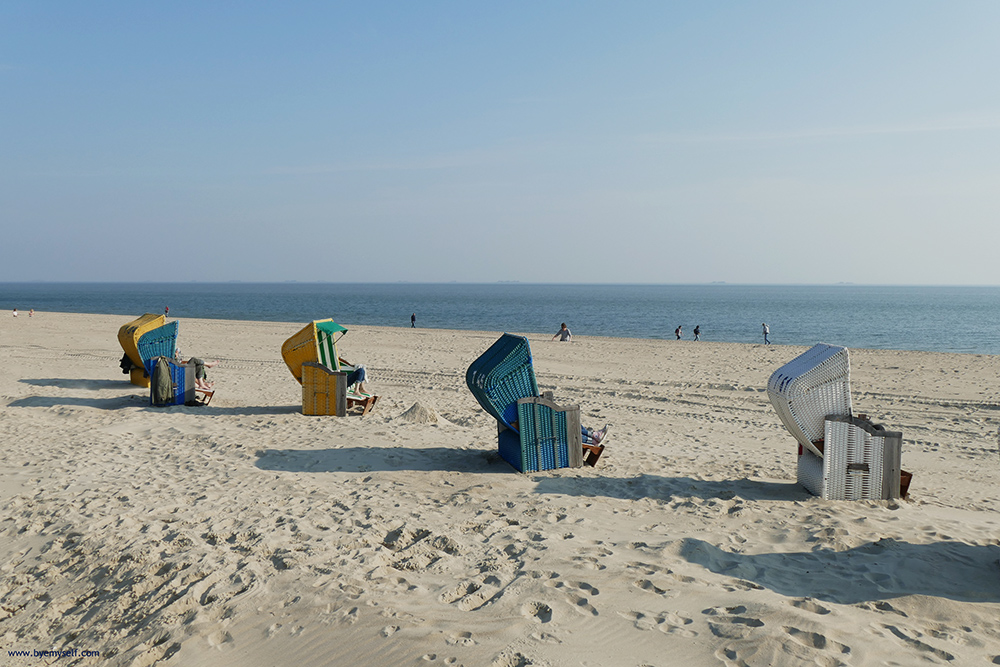
They call it a Strandkorb, hence, a beach basket. It shelters you perfectly against the wind while you enjoy the rays of the sun. When it’s warmer, you just push back the roof and – voilà – you have the perfect beach bed.
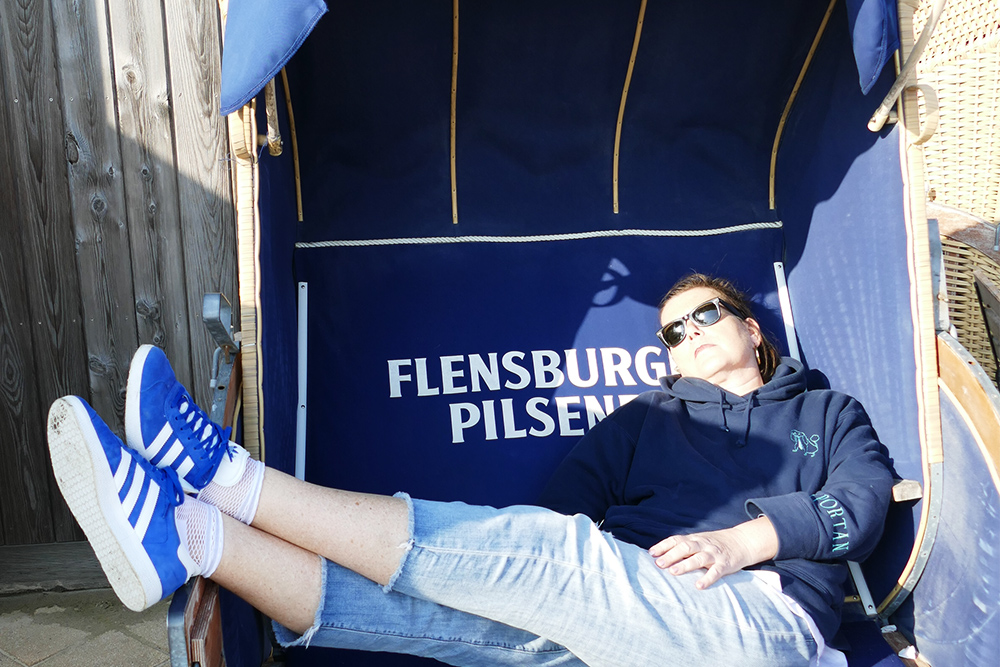
Sleeping On The Beach – In Style
For about four years now, it’s even possible to spend the night in a Strandkorb. They developed a new kind that’s a bit wider, so it houses two people.
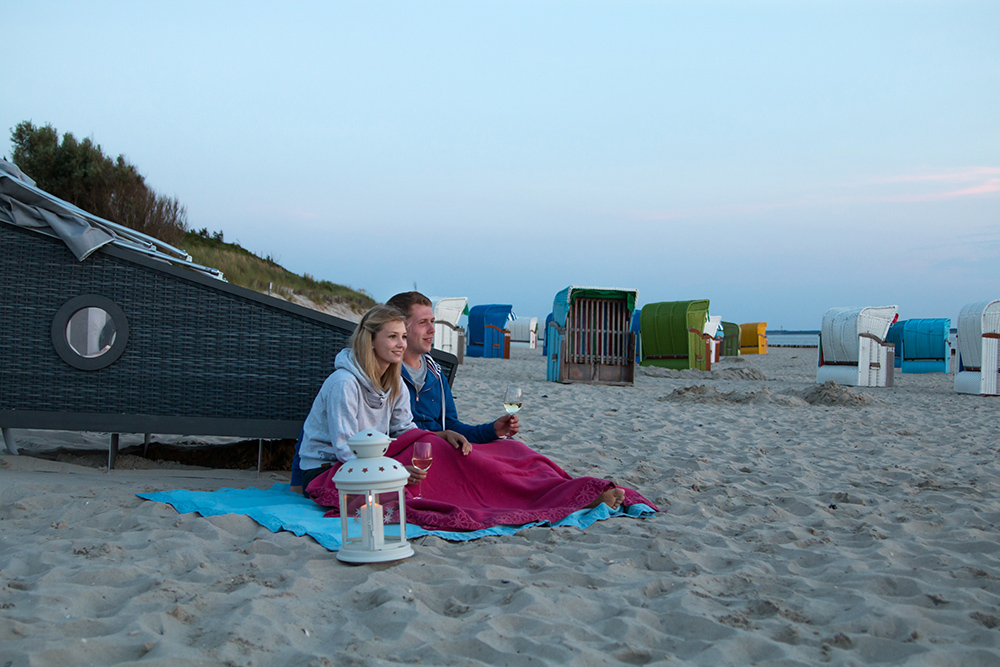
(Photo: © Föhr Tourismus GmbH / Foto: Jens Oschmann)
The owner hands you the key, and you can spend a romantic and cozy night under the stars.
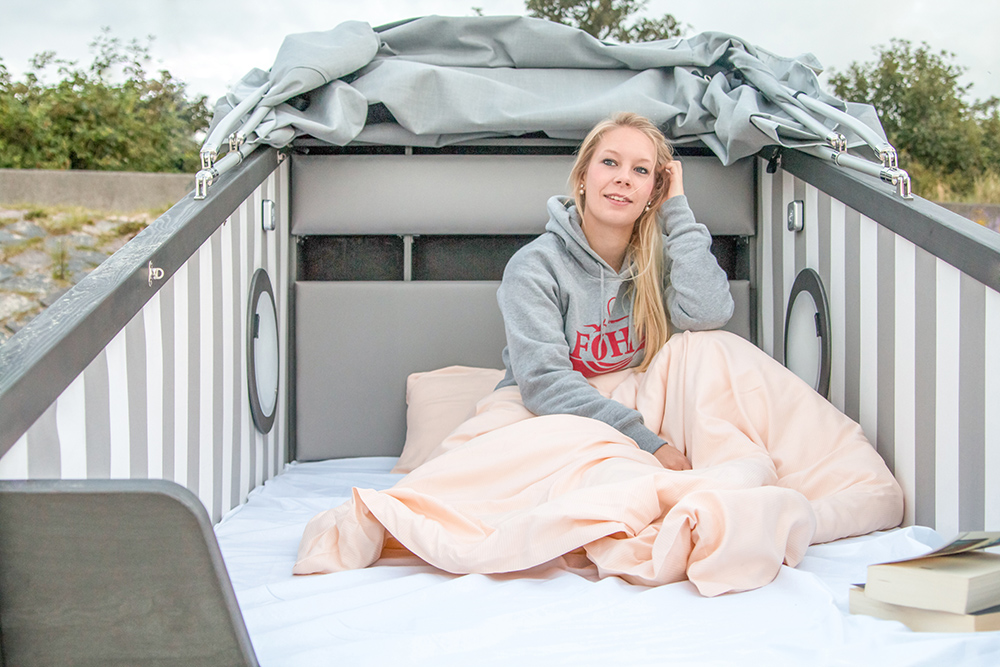
(Photo: © Föhr Tourismus GmbH / Foto: Jens Oschmann)
There is a bathroom nearby, albeit some of the showers have only cold water, but come on, be a sport! And if there’s a cloudburst, you can cover the Strandkorb with a hood similar to those of a convertible. However, this one-of-a-kind accommodation is only available during the summer season from May to September, obviously.
Föhr’s Past
It’s certainly interesting to learn a bit more about Föhr’s history. The Dr. Carl-Häberlin-Friesen-Museum, the Frisian museum at Wyk, is the perfect place for doing so.
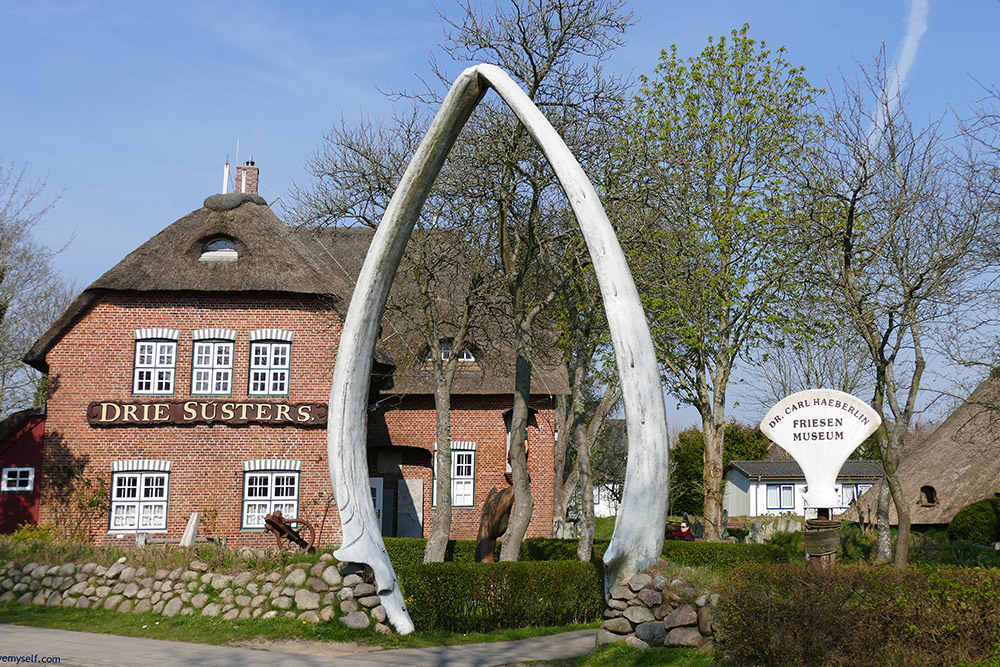
Here, you’ll learn about the whale catchers who were active in the 17th and 18th centuries. They are also telling you why so many Föhrers migrated to the United States in the middle of the 19th century.
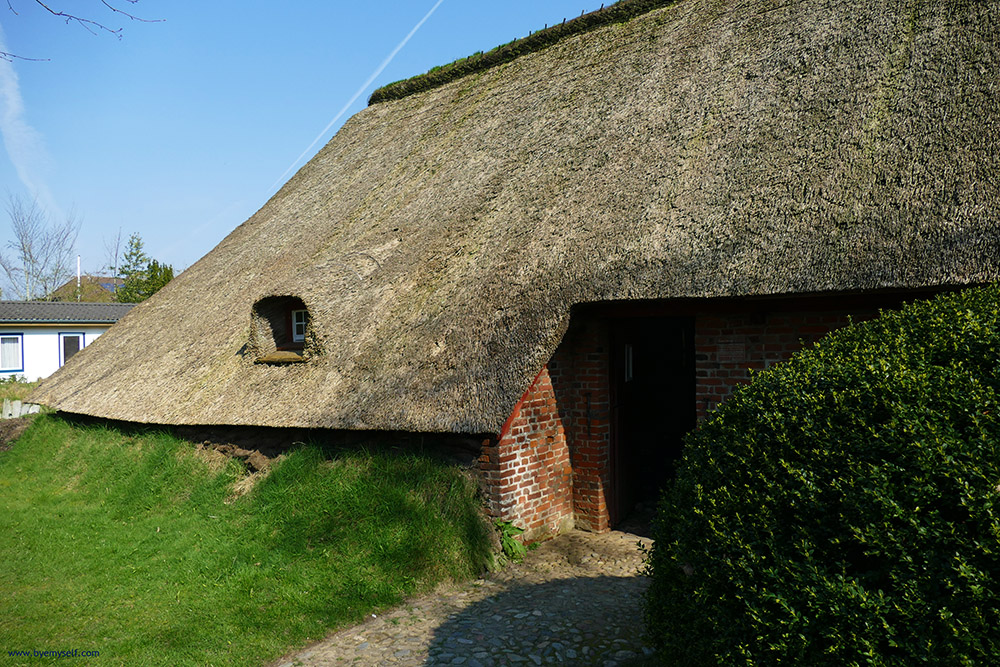
You’ll see the traditional attire, furniture, and utensils in three original buildings. One of those is Föhr’s oldest house, built in 1617.
Also, there is an antique post mill. It was brought here from Langeneß, the largest of the Halligs.
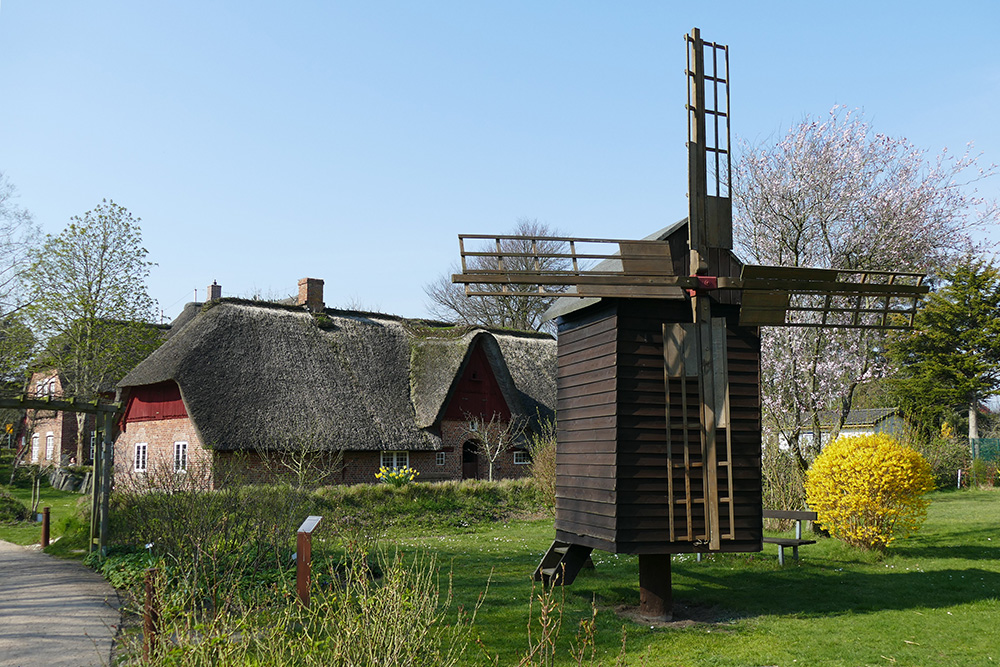
Dr.-Carl-Häberlin-Friesen-Museum
Rebbelstieg 34
25938 Wyk
Phone: + 49 – 4681 – 2571
Email: info@friesen-museum.de
Regarding their opening hours, please check their website since these vary according to the different tourist seasons.
Out Of Wyk
So yes, Wyk is a nice little town, but I’m not coming to Föhr to stay in a town. I’m coming for the seclusion and serenity! Obviously, I find these features between the fields and the meadows surrounding all the –ums, those lovely little hamlets and villages. Here, most of the farmhouses are reed thatched and have some wise slogans painted around the doorframe.
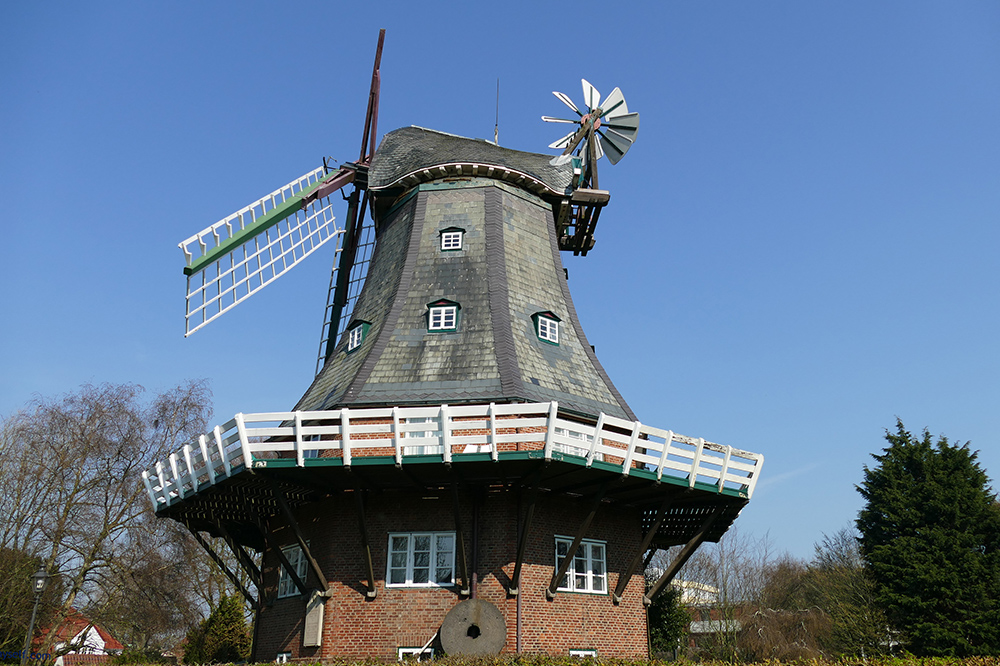
So come on, jump on your bike and let’s hit the road.
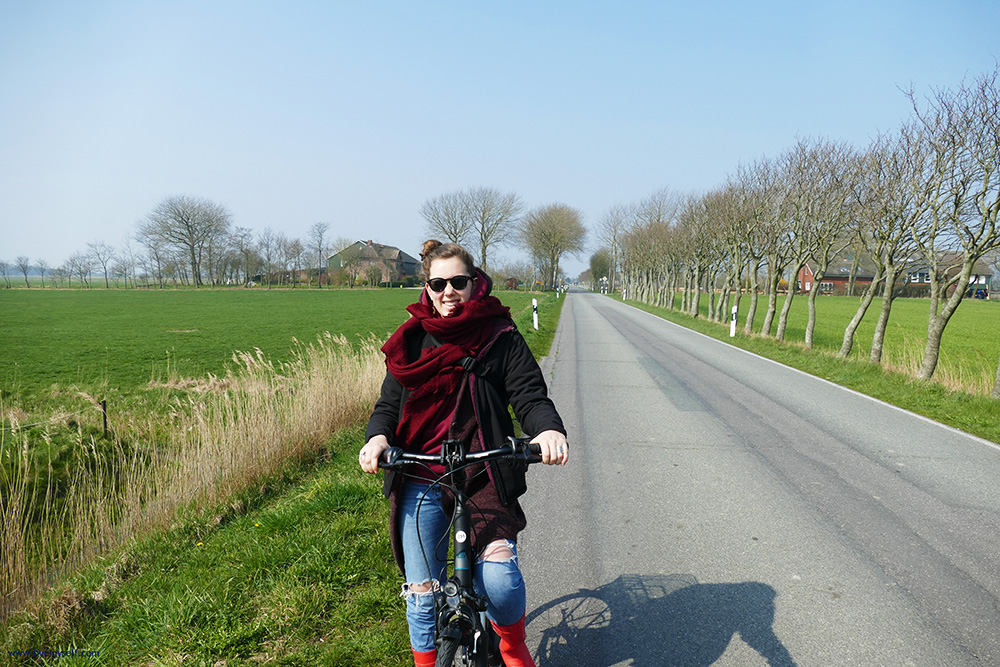
Although there are a couple of elevations, namely 17 burial mounds from the Bronze Age, the island is mostly flat and therefore perfect for cycling. However, it’s an island amidst the northern sea, so even on a warm and sunny day, a strong breeze can make riding a bike pretty challenging. Therefore, I really recommend renting an e-bike that helps you to cycle against the wind when needed.
Wrixum
We are leaving Wyk on route L214 towards the northwest. This sounds more like a serious road trip than the leisurely bike ride we are taking. You’ll first get to the village of Wrixum, a name that sounds like borrowed from an Asterix book.
Wrixum’s landmark is a windmill, erected in 1851 and functioning till 1960. At that time, grinding corn in a mill like this simply wasn’t economically interesting anymore.
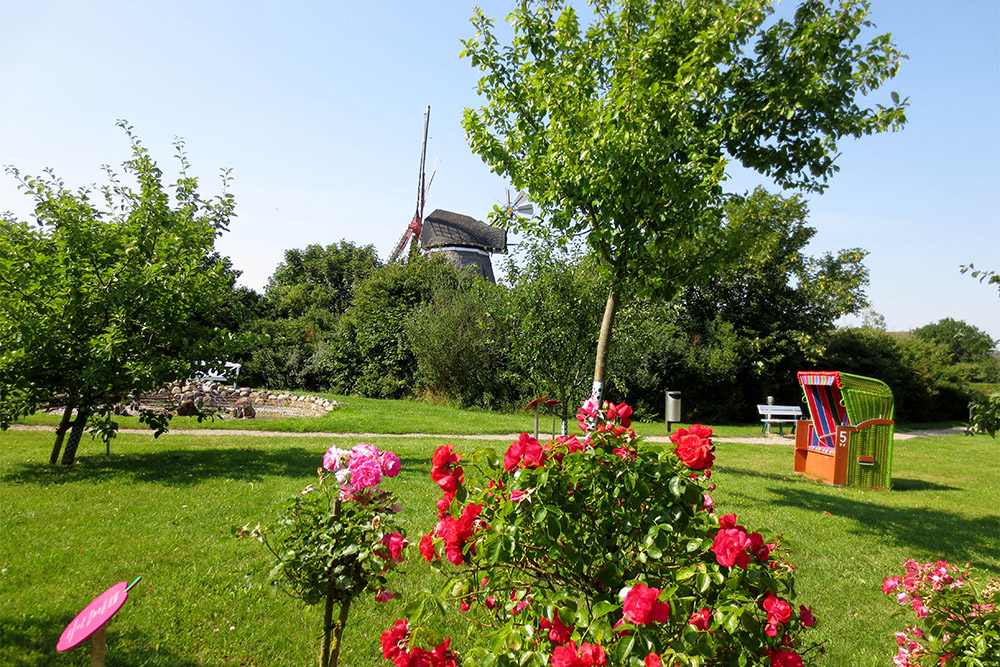
After a checkered history, the community of Wrixum bought the mill in 2016 and is trying to reanimate it. The mill is now heritage-protected, and the association is collecting money to buy it new wings. The old ones had to be detached for safety reasons.
Eventually, the mill should grind again, and the baked goods will be sold at a bakery next door.
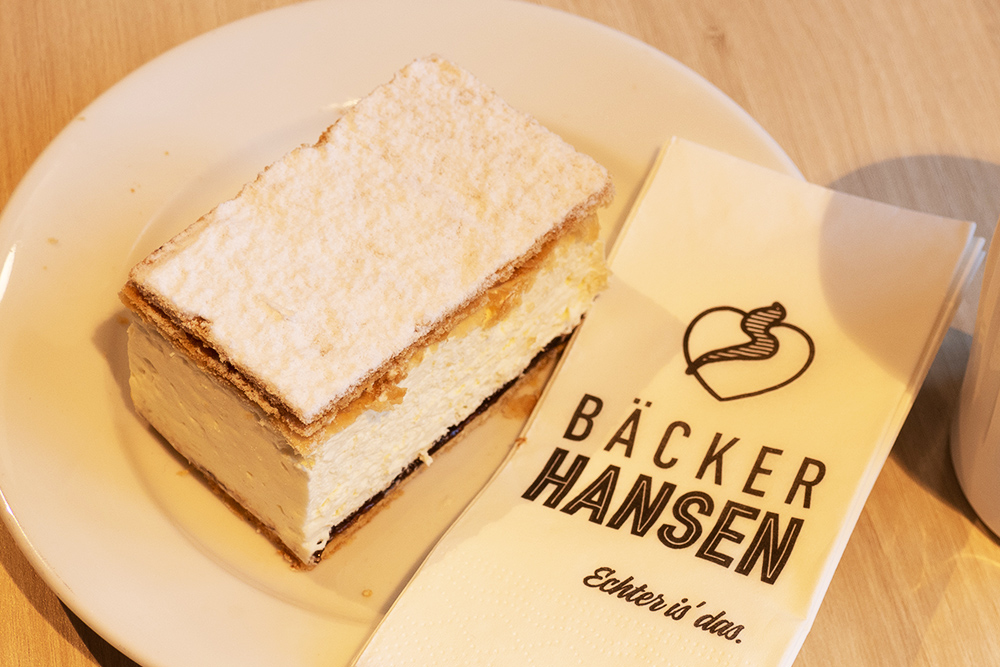
Wrixumer Mühle
Hardesweg 54
25938 Wrixum
You can visit the windmill on Sundays at 2.30 p.m.
Oevenum
As you keep on cycling northwest, the country road takes you straight to the village of Oevenum, island-famous for treats and dainties. There are farm stores where you get the very freshest produce, and also a farmers’ market.
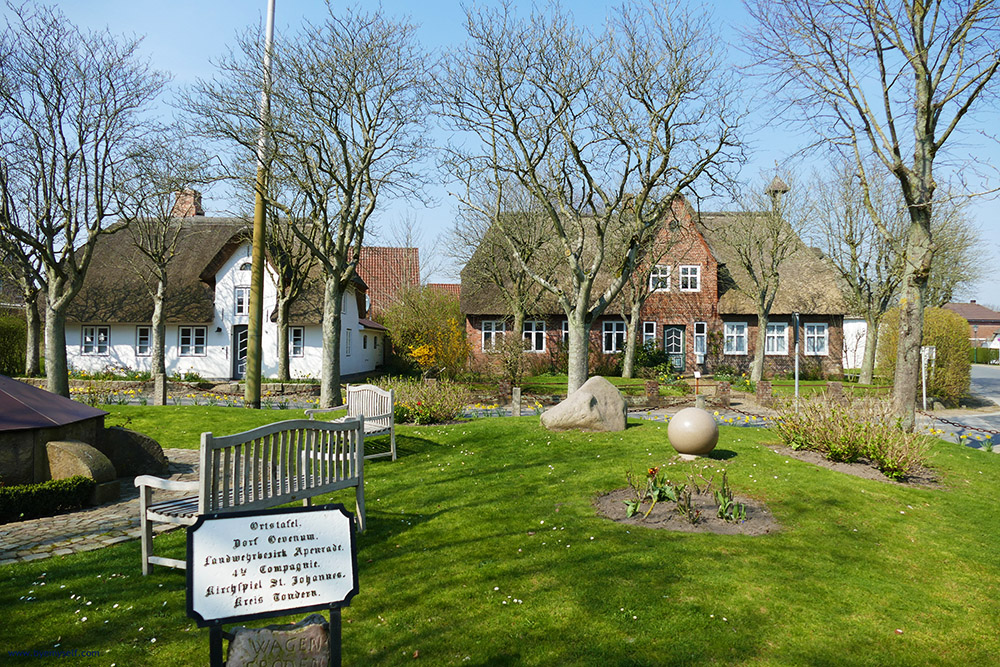
Homemade candy from the sweet shop Snupkroom, which is Frisian for sweets, is great to enjoy on the spot or to bring home as a souvenir.
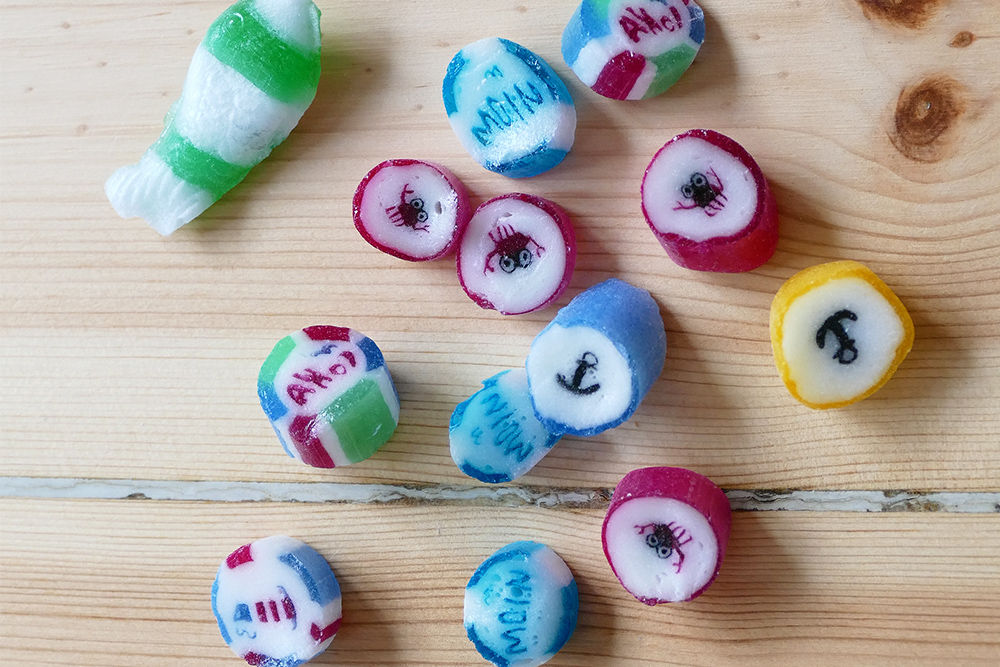
Föhrer Snupkroom
Wohlackerum 2
25938 Oevenum
Phone: +49 – 4681 – 746 21 38
With your pockets full of snupkroom, keep riding down the main village road until you find yourself in Alkersum.
Alkersum
Alkersum is an –um not to be missed for two great attractions, art and the art of food.
Dr. Frederik Paulsen Jr. founded the Museum Kunst der Westküste, the Museum Art of the West Coast.
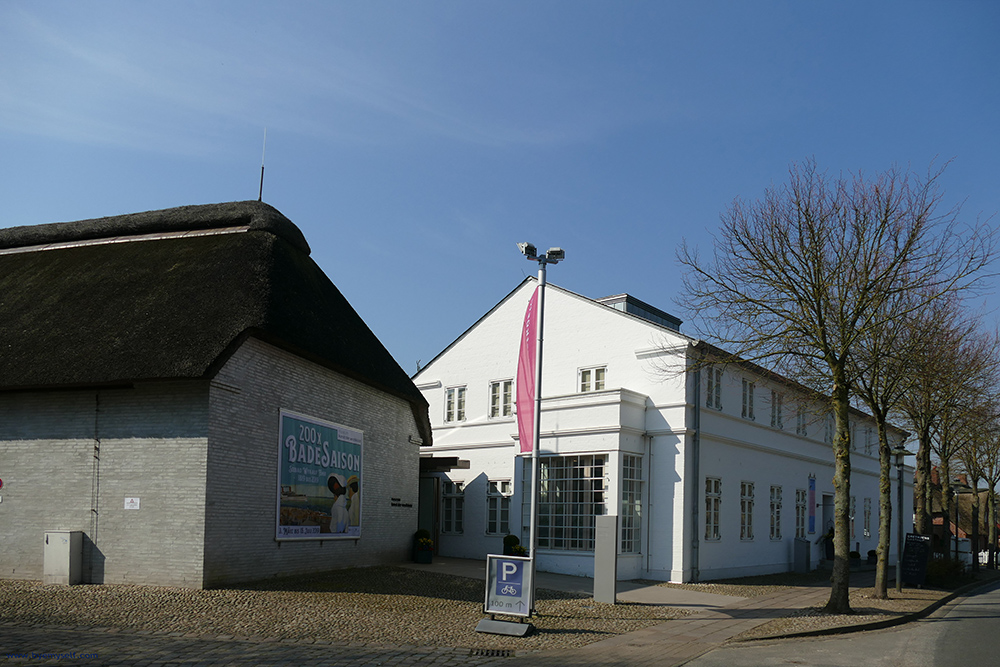
Dr. Paulsen’s father was born in Dagebüll in 1909. As a young man, he had to flee the Nazis to Sweden and Switzerland because of his opposing political ideas. In Sweden, he founded the pharmaceutical company Ferring. In 1997, he died in Alkersum.
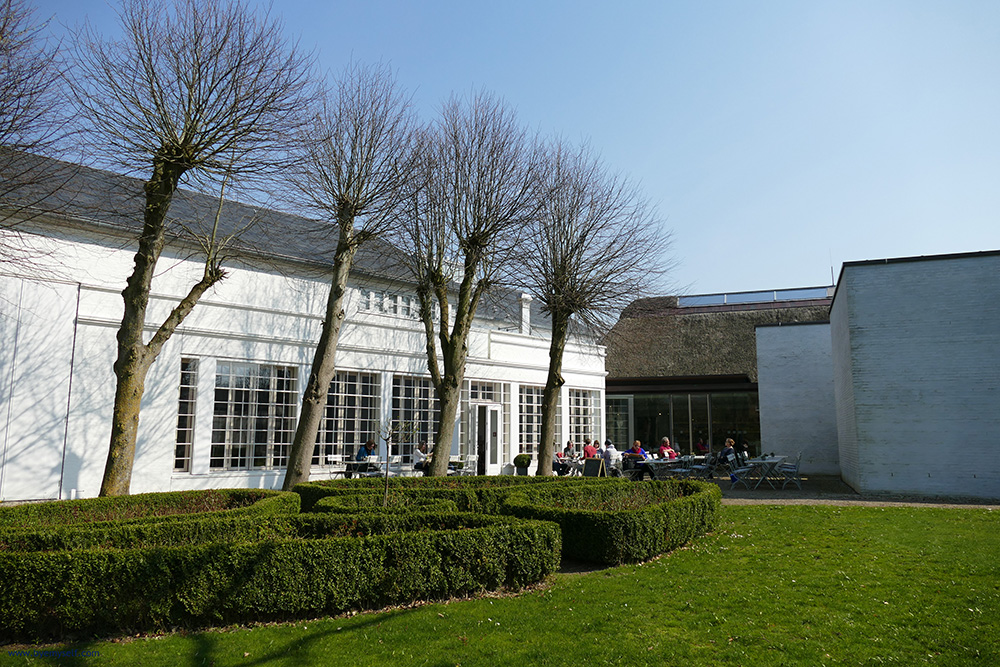
Paulsen’s art collection is the backbone of the museum, which was founded in 2009 in the very village where his father died. The museum was installed at the former tavern Grethjens Gasthof. This pub used to be a hangout for German and Danish artists in the 19th century. The exhibition consists of paintings by Edvard Munch, Max Liebermann, Max Beckmann, Peder Severin Krøyer, and many other Nordic masters.
Today, the temporary exhibitions deal with the topics sea and the coast.
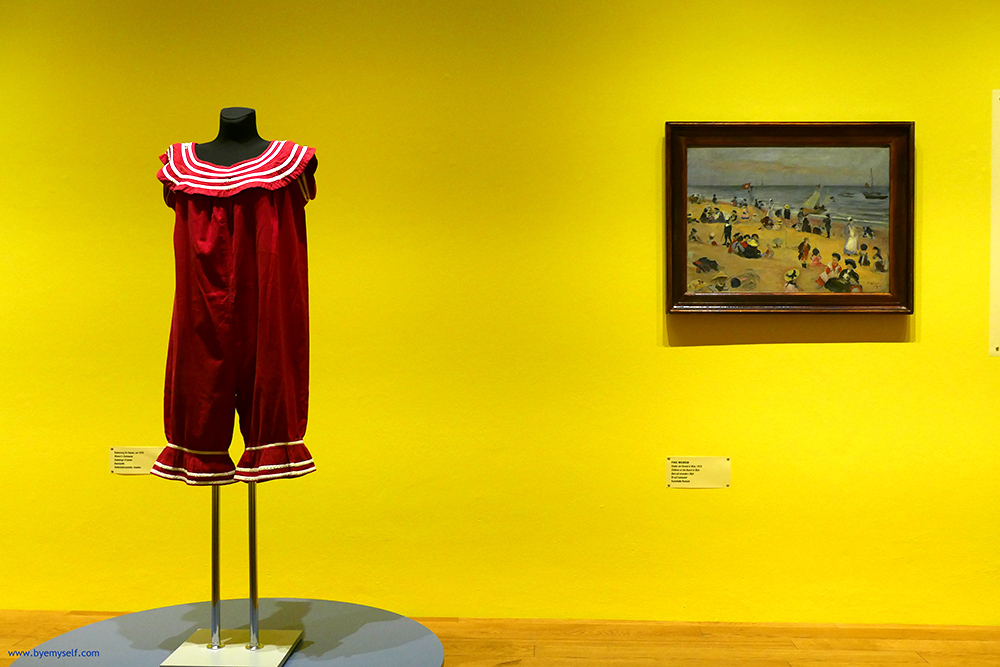
The venue, its history, and the art on display are interesting and inspiring and not to be missed when visiting Föhr.
Museum Kunst der Westküste
Hauptstraße 1
25938 Alkersum
Phone: +49 – 4681 – 74 74 00
The museum is open Tuesday to Sunday from 10 a. m. to 5 p. m.
Fresh Dairy Products
Now, the other place to visit in Alkersum is not artsy, however, very original: At the farm store Hofladen Hartmann you can buy all sorts of freshly homemade dairy.
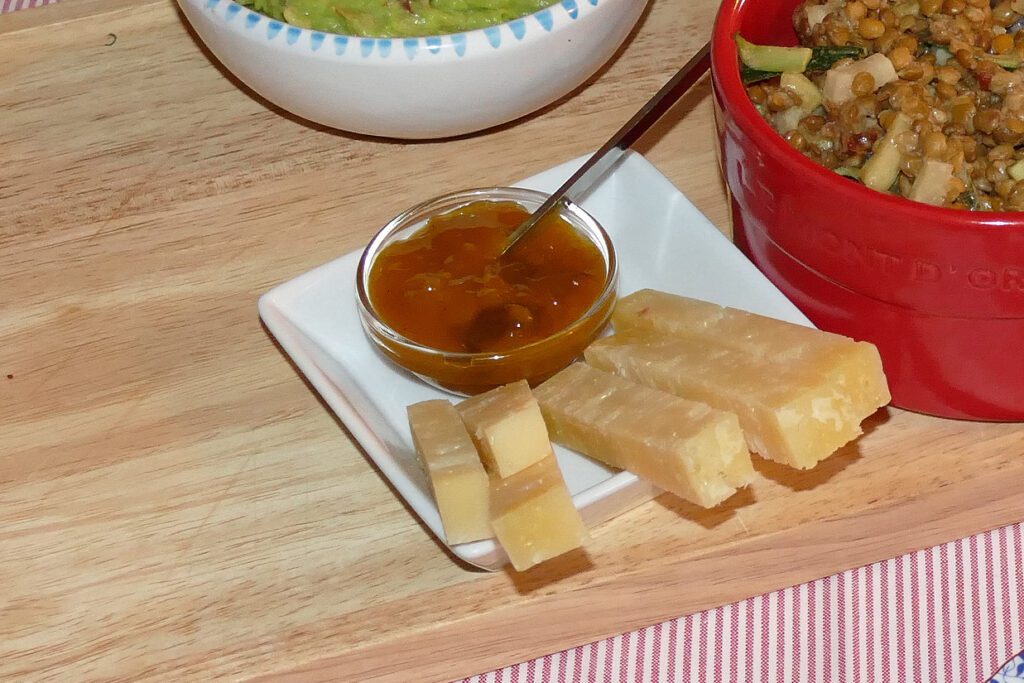
It’s closed?
No worries: Inspired by a candy machine, you can buy their goodies, such as cheese and yogurt, from a machine.
There, you can also obtain empty glass bottles. What for? Well, next to the diary machine is, inspired by a gas station, a milk station.
Put your brand new bottle in the little compartment, insert one €uro, and one liter of fresh milk will pour into the container.
So much fun!
Hofladen Hartmann
Hauptstraße 9
25938 Alkersum
Phone: +49 – 4681 – 24 92
If you prefer to shop the conventional way, the farm store is open Monday to Friday from 9 a.m. to 6 p.m. and Saturdays to 1 p.m. On Sunday, you have to use the ingenious machines.
Oldsum
So Oevenum is for food, Alkersum for the art, and the next village on the road L214 would be Oldsum, and that stands for tradition, history, and handicraft. Today, at many of the thatched half-timber houses you’ll find cozy cafés, galleries, and specialty shops selling wool and ceramics, but also jam and other local delicacies.
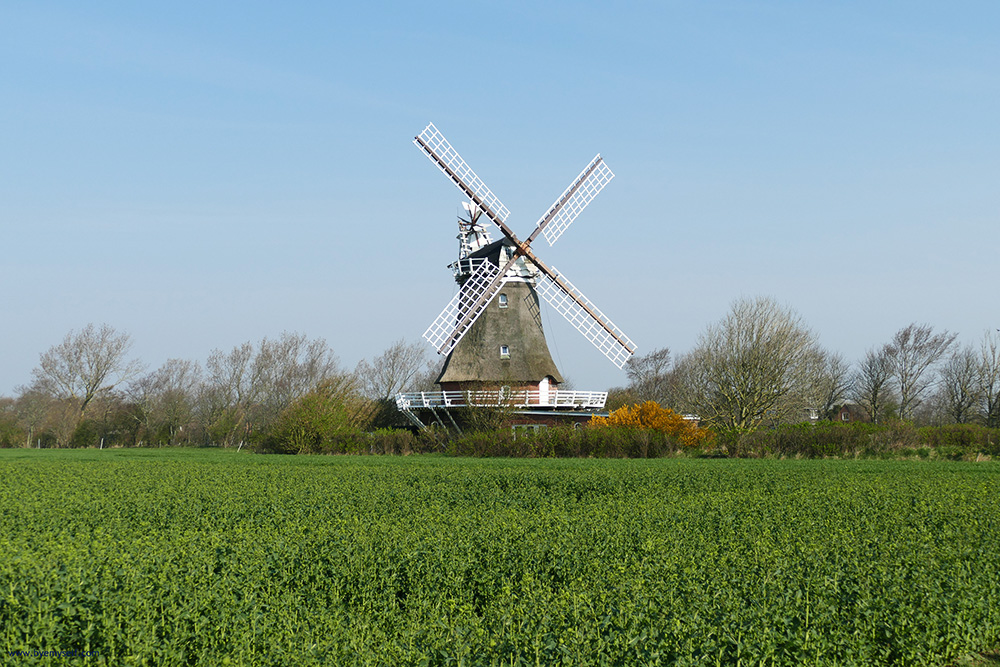
In the 17th century, Oldsum was an important whale-catcher village: Commander Matthias Petersen caught 373 whales in his life. Look out for his gravestone in the cemetery around the St. Laurentii church in Süderende. We’ll get there in a moment.

(Photo: Daniel Ponten, Grabstein matthias petersen, detail, cropped to 2:3, CC BY-SA 2.0 DE)
Staying at a Frisian House
Talking ’bout whale-catchers: Another one was Arfst Ketels, born in 1808. When he died in 1884, he left a beautiful house that today belongs to Ms. Marion Koziol. For the record: She is not catching whales.
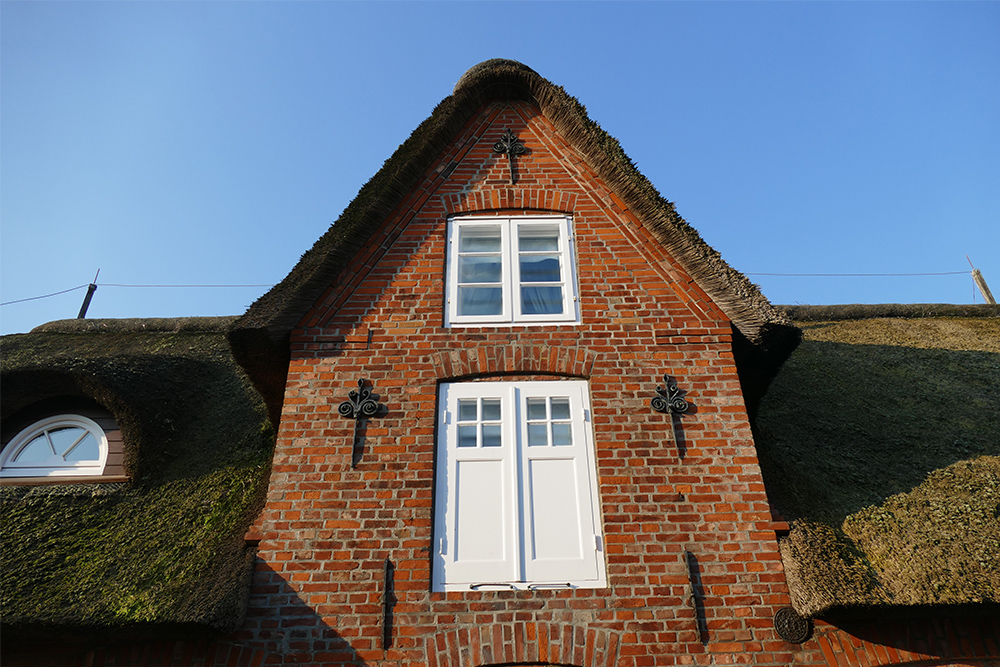
Marion, who moved to Föhr from Southern Germany, did a great job in restoring the old structures and transforming the house into a real -um, a cozy home. Now, she’s generously sharing it with others by renting three of the upper rooms to guests.
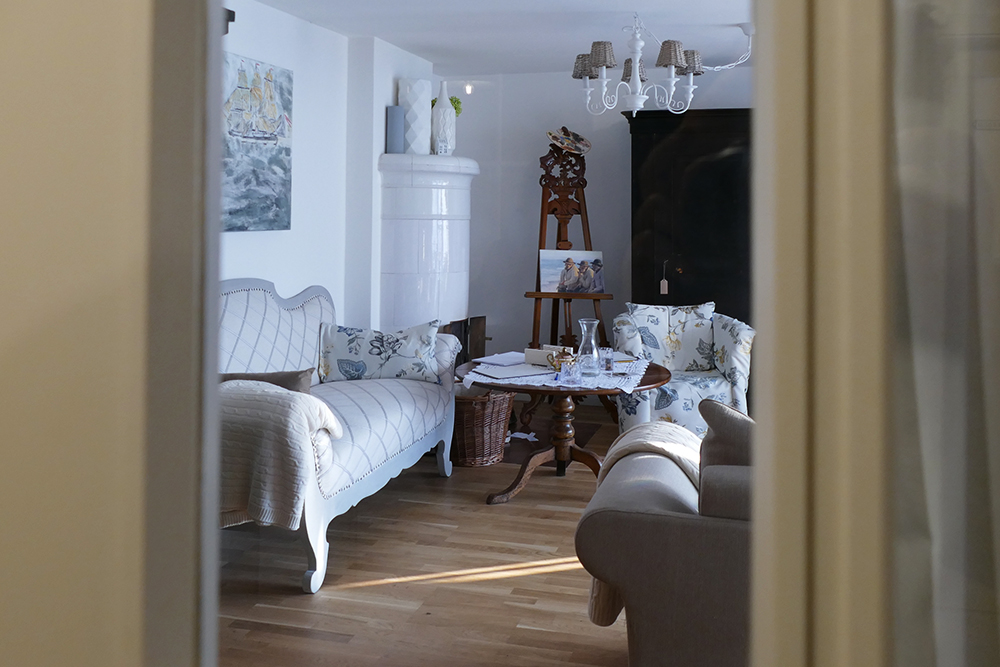
And since Marion loves to bake and cook, you can enjoy a wonderful breakfast prepared to your liking before you leave to explore the island and the sea.
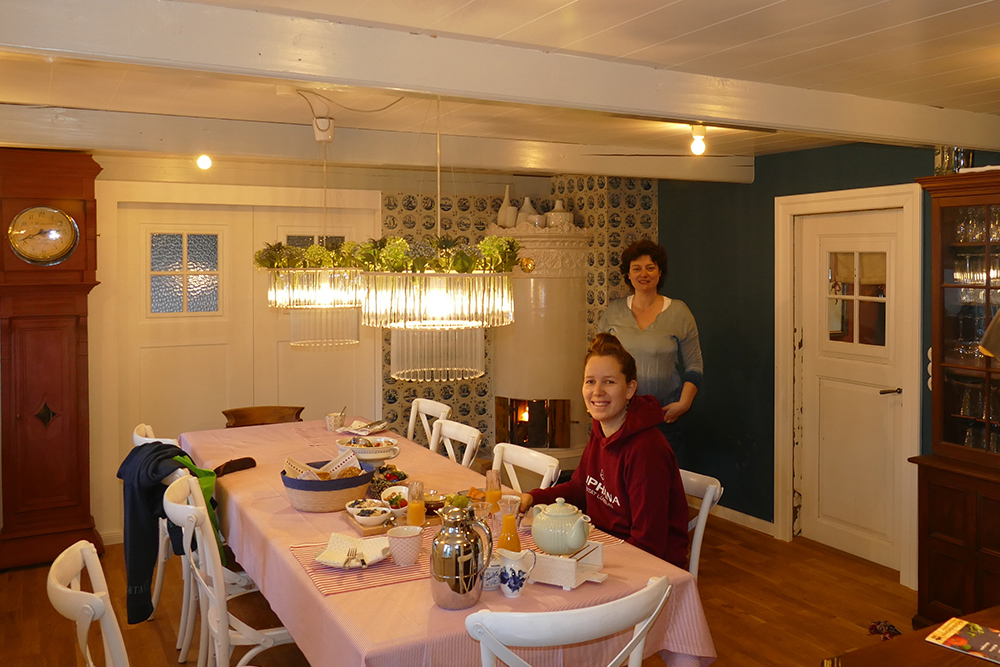
If you like, she awaits you in the evening in the cozy dining room with an opulent dinner, like, for instance, her Frisian tapas, a variety of local delicacies with a modern twist. Prepare for a long, filling, and fulfilling evening!
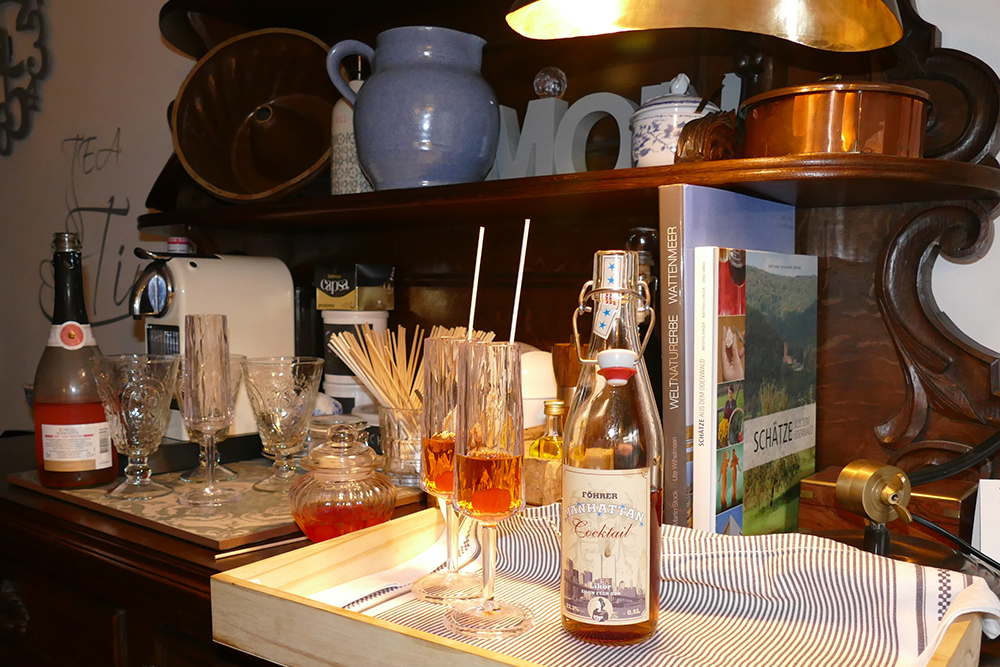
By the way, Arfst Ketels’ gravestone is at St. Laurentii. It stands in the third row at the northeastern corner.
Update 2025
Sadly, Marion’s house is not operating as a B&B any longer. However, you will certainly find another cozy’n’convenient accommodation on this map*:
Dunsum
As you might remember from my post on Cuxhaven and the hike across the tideland to the island of Neuwerk, I’m a huge fan of the Wadden Sea and hiking around in the mud. To me, no visit to the North German coast would be complete without marching in the mud to see all the wonders nature has created, and we should cherish and protect.
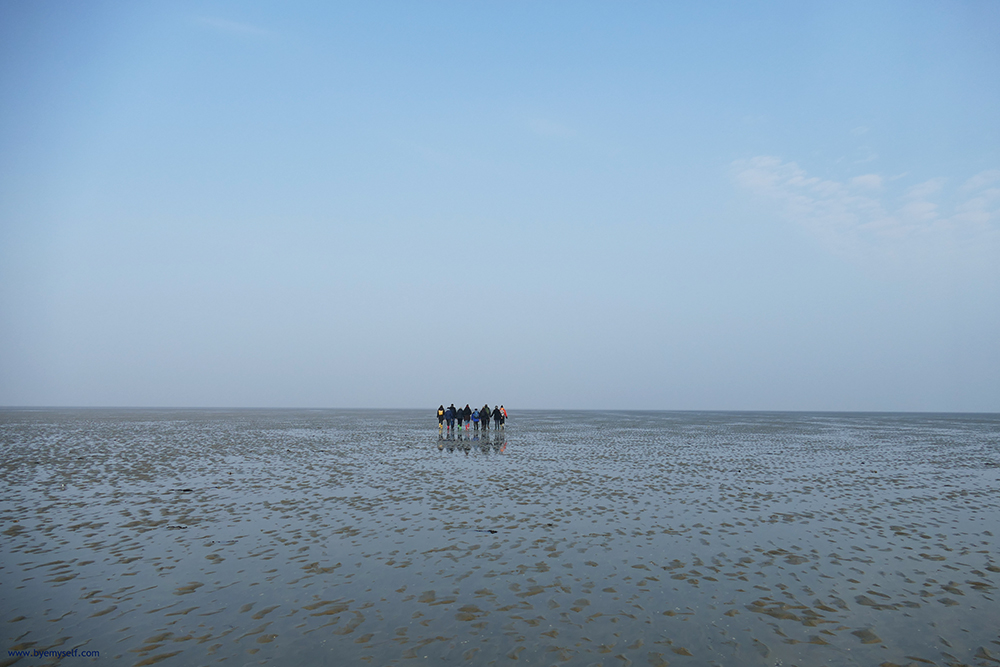
While every guided hike on the tideland is an excursion into wonderland, in Dunsum, they throw in a handful of seals.
You can hike towards the island of Sylt, and approximately halfway, there is a sandbar where the chubby, cute gray seals are frolicking in the ice-cold waters or lazing on the sand.
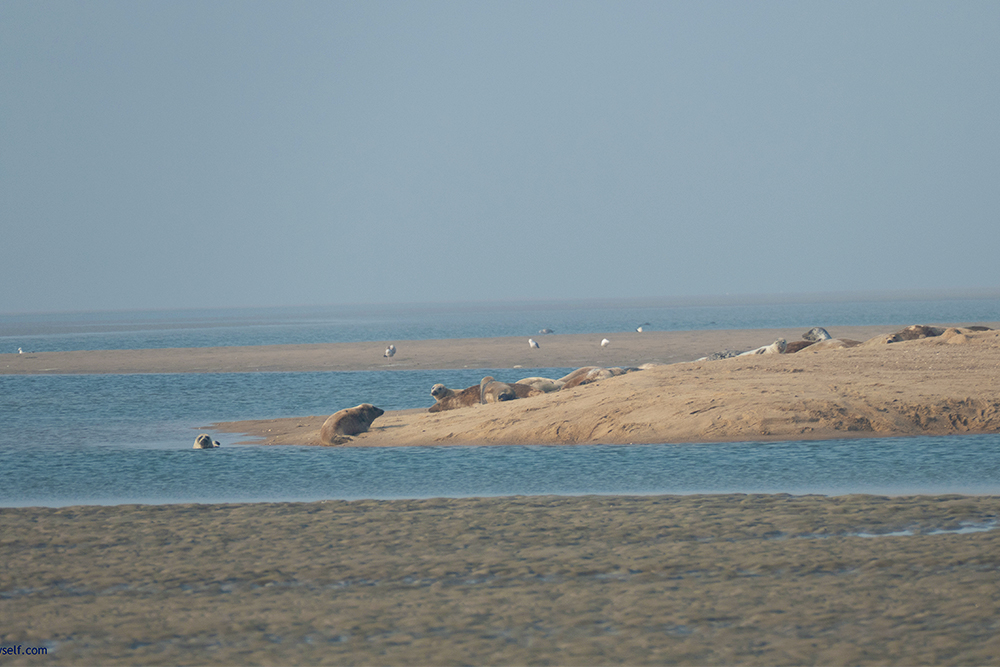
Crossing The North Sea Walking
Since the waters come and go and there are relatively few people getting to the sandbank, it’s also a haven for shell collectors. Not only is the amount simply amazing, but they are also intact since few feet are trampling around. So if you take this hike and you love to collect shells, bring a big bag with you!
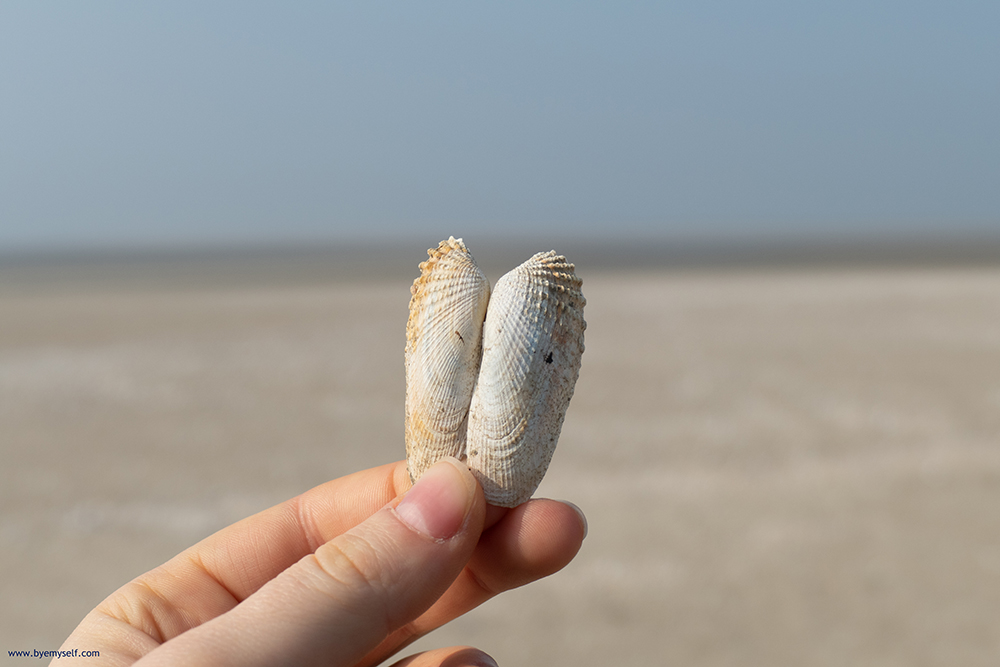
The hike to the sandbar and back is in total about 8 kilometers. The schedule depends on the tides, obviously.
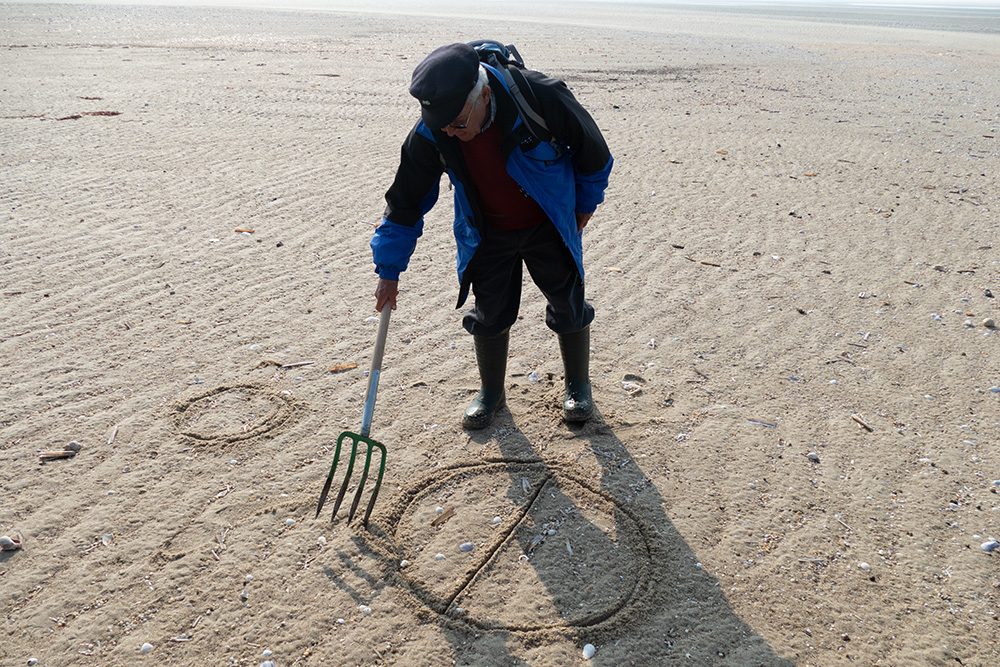
You can get info at the Tourist Information or at the tavern
Zum Wattenläufer
Dunsum
Phone: +49 – 171 – 1 13 36 28
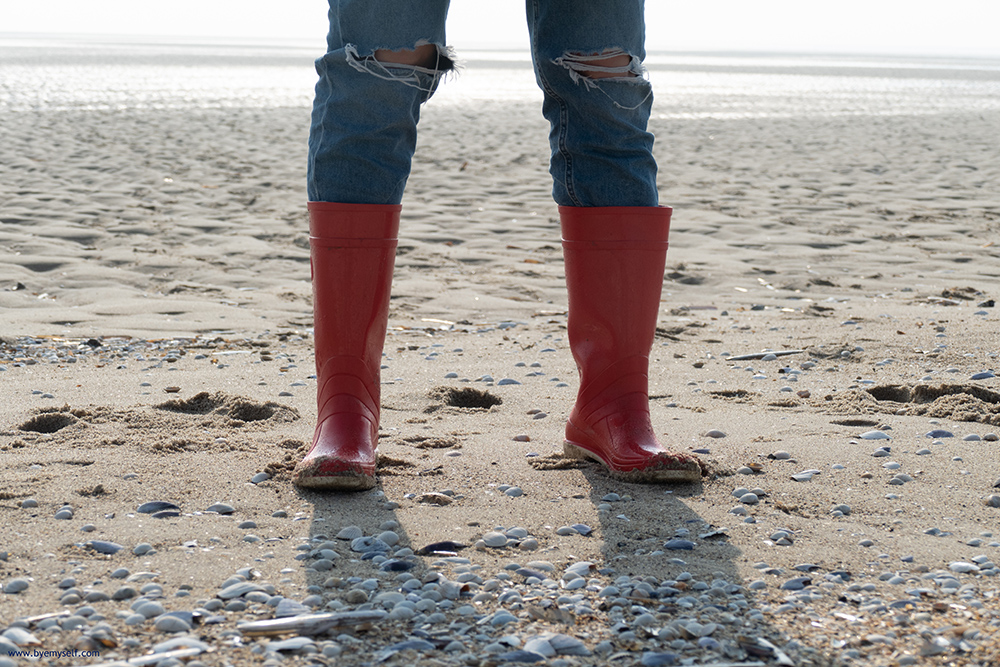
If you want to hike and didn’t take your own gumboots, you can rent them at a small price
Antiquitäten & Gummistiefel-Verleih
Sandwall 58
Wyk
Phone: +49 – 173 – 8 11 56 70
When the weather is warm enough, there are even hikes all the way to the neighboring island of Amrum. Although the distance is only about 8 kilometers, the tidal creek at the end of the hike is thigh-high, so you have to cross wearing beachwear. Believe me, you don’t want to do this in let’s say March.
To get back to Föhr from Amrum, you take a ferry.
Obviously, you can visit Amrum, Sylt, and many of the Halligs by ferry. But come on, do you really want to miss the opportunity to basically walk on water from isle to isle?
Süderende
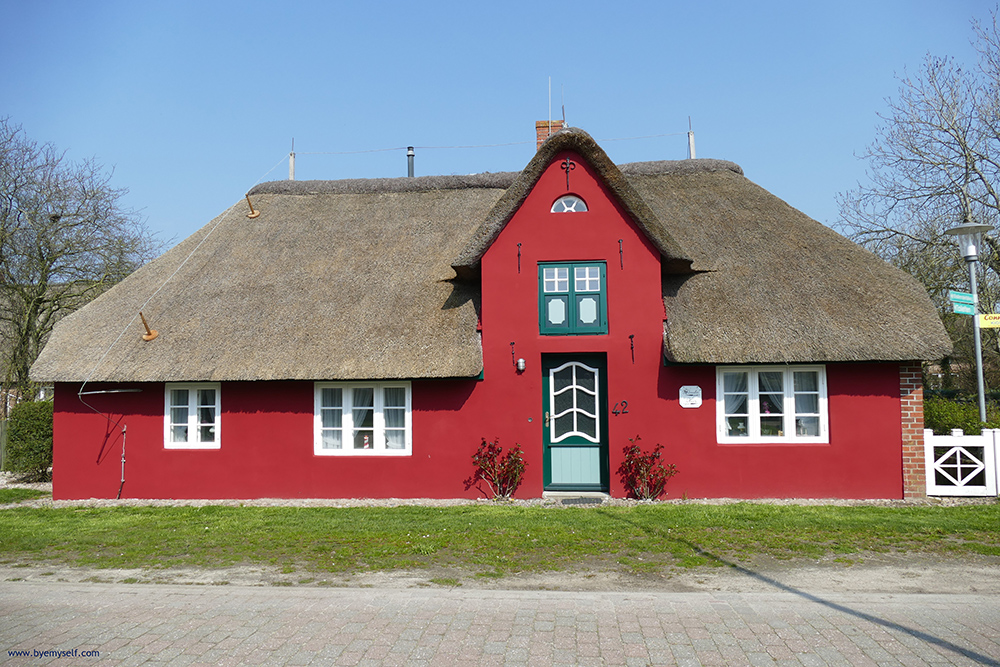
Süderende – although, obviously, not an –um – is also a very cute village with pretty houses and, most importantly, a very impressive Lutheran church, St. Laurentii. The original structure stems from the late 12th century. However, the building was extended for the first time already in the 13th century and underwent a couple of changes. You can see this from the very different bricks and stones.
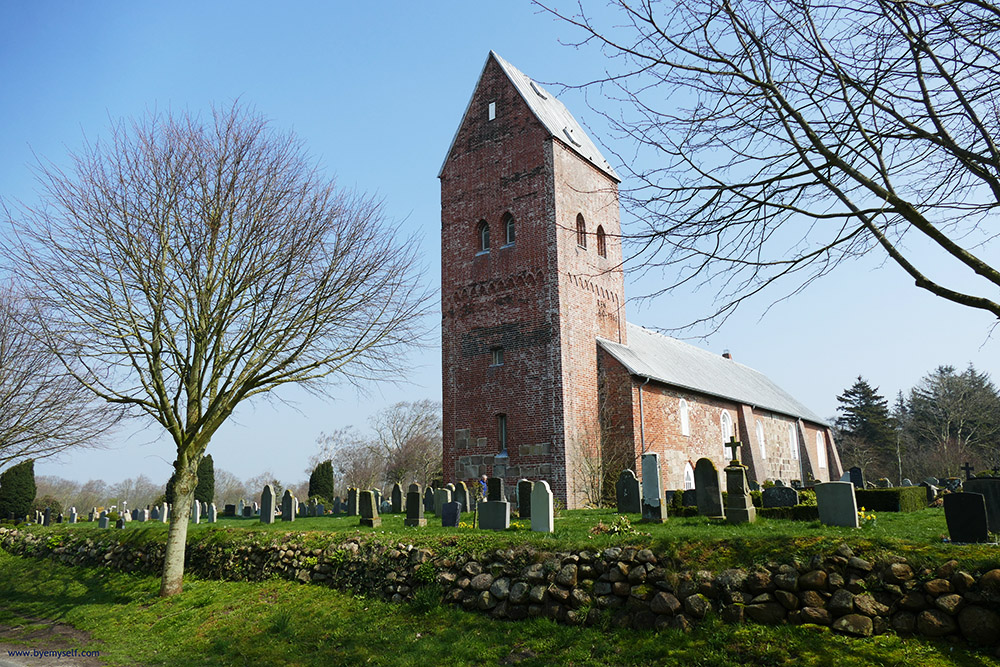
The most fascinating part that all Protestant churches in Föhr have in common is the graveyard surrounding the house of worship. You will notice a great number of beautifully engraved stones, the so-called Talking Gravestone. Following an old tradition, the deceased’s biography is summarized in artful writing, telling about the exciting life of the whale catchers.
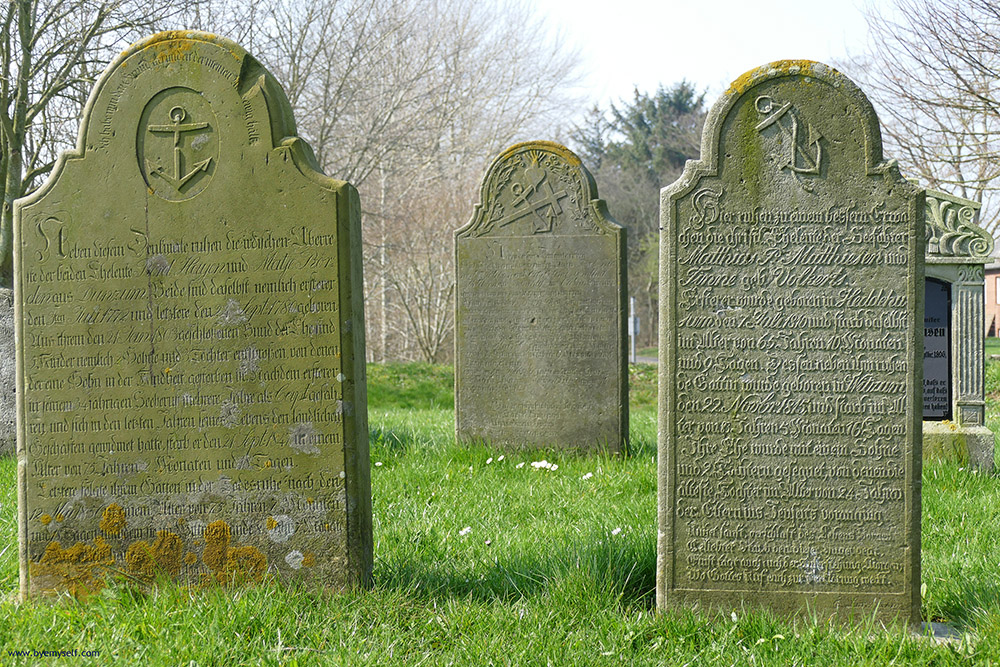
Also, pay attention to the floral decoration. The family’s men and sons are mentioned on the stone’s left side in some tulip-like flowers. Women and daughters to the right in a four-blossomed flower. A broken flower is telling you that the person died before the family tombstone was finished.
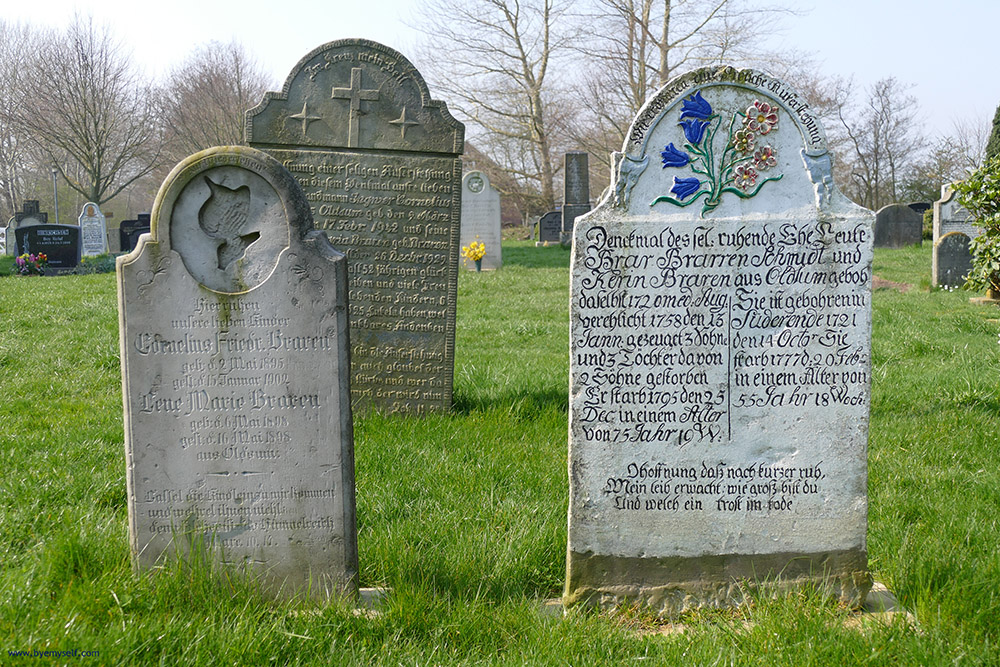
These graveyards are very unique and typical of North Frisia.
By the way, the North of Germany is mostly protestant, so there is only one Catholic church on Föhr, the St. Marien Kirche in Wyk.
Utersum
Here you’ll agree with Föhr’s self-proclaimed title Friesische Karibik, Frisian Caribbean: Miles and miles of fine sand along the North Sea make this village the epitome of a beach vacation.
Even as the tide is low, you can take a dip in a tidal creek.
Facilities such as bathrooms and showers are great. Also, there are designated beach areas for different needs, like a dog beach or even a non-smokers’ part.
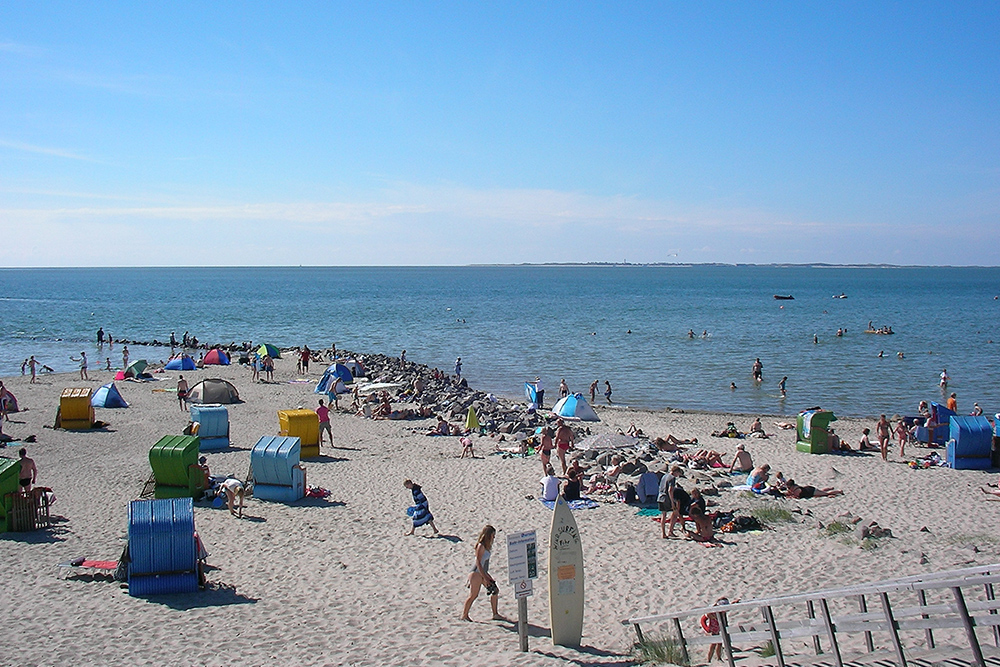
(Photo: Pincerno at German Wikipedia, Pincerno – Utersum 1, cropped to 2:3, straightened, CC BY-SA 3.0 DE)
Since Utersum is on the island’s very West, not only is there a good view of the neighboring island of Amrum. Also, the sunsets here are just spectacular!
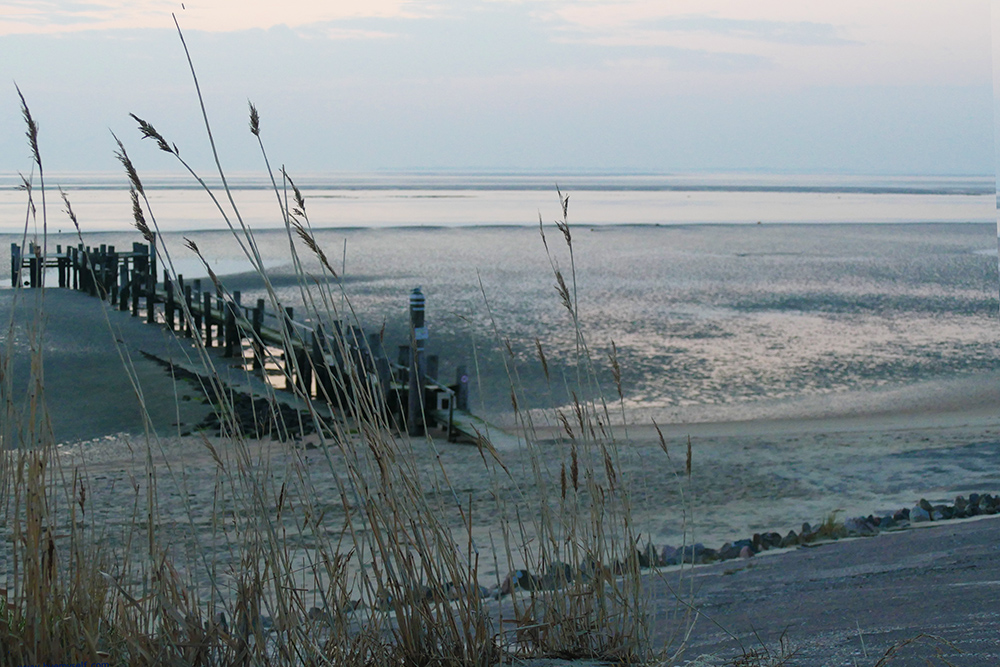
Witsum
River deep – mountain high: Föhr’s smallest village Witsum is adjacent to the island’s only river, the Godel. The endless fields and the humidity create a unique biotope, ideal for all the resting’n’nesting birds.

Oh, I almost forgot that one of Föhr’s highest elevations, the 11-meter-high Sylvert hill, is also located in Witsum. You see, this tiny village seems to have it all.
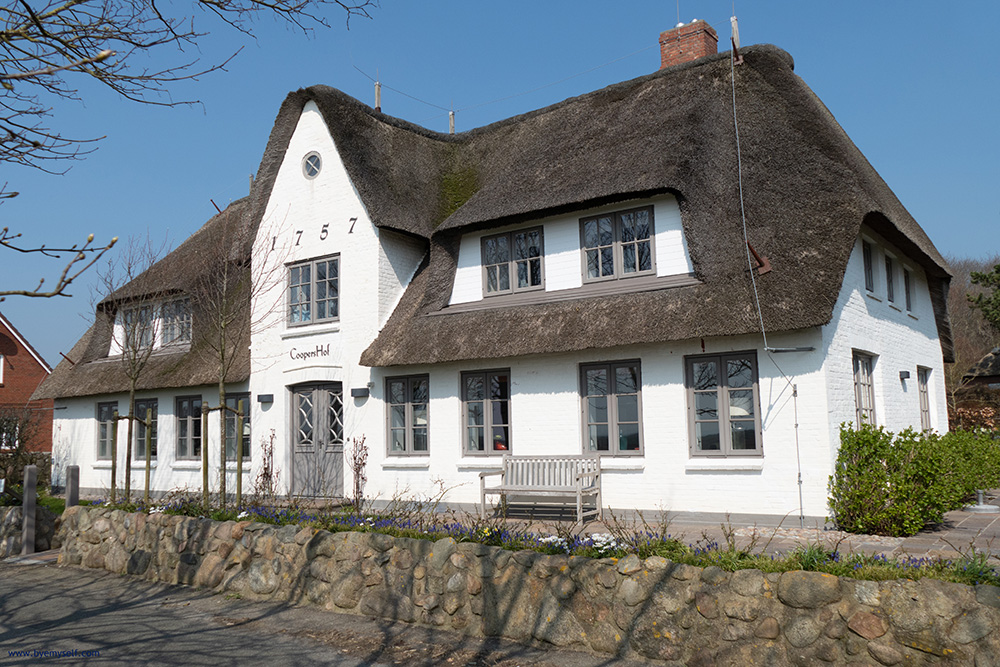
Nieblum
All the -ums are super-cute and have lovely corners, but Nieblum is the prettiest of them all. Consequently, also the most touristy one. Especially since there isn’t only the incredible number of perfectly maintained Frisian houses but also the proximity to the Frisian Caribbean, hence, the North Sea.
On Nieblum’s beach, everyone finds his or her favorite activity; or passivity in case lazing in the sun is your personal favorite.
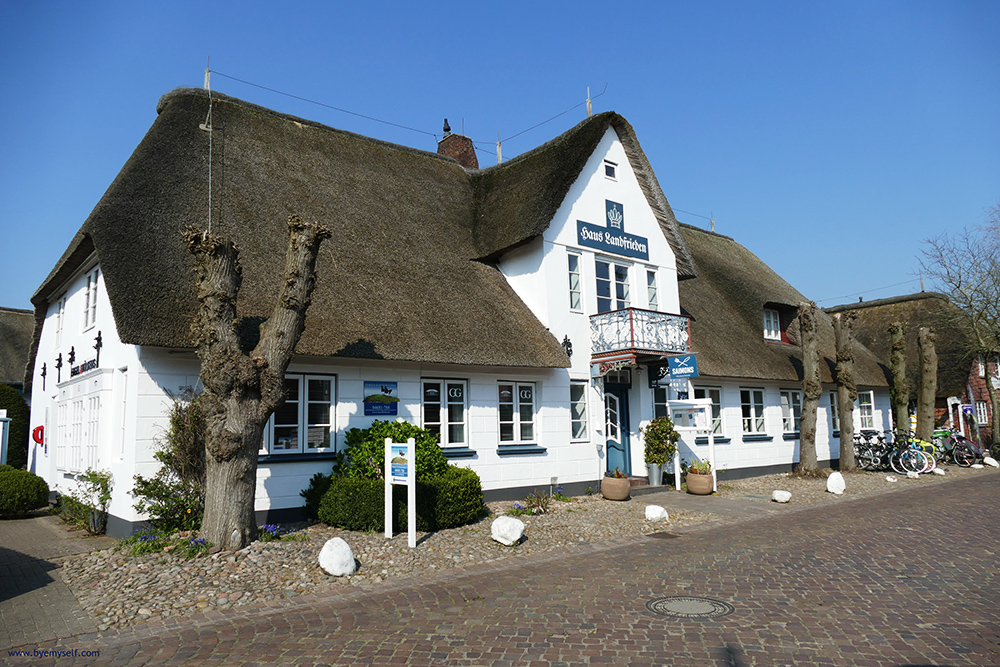
While the whale catchers used to live in Oldsum, Nieblum was for the captains. To this date, it is reflected in the magnificent Frisian mansions. Nieblum, as a village, considered Föhr’s most precious gem, won various village competitions for a reason.
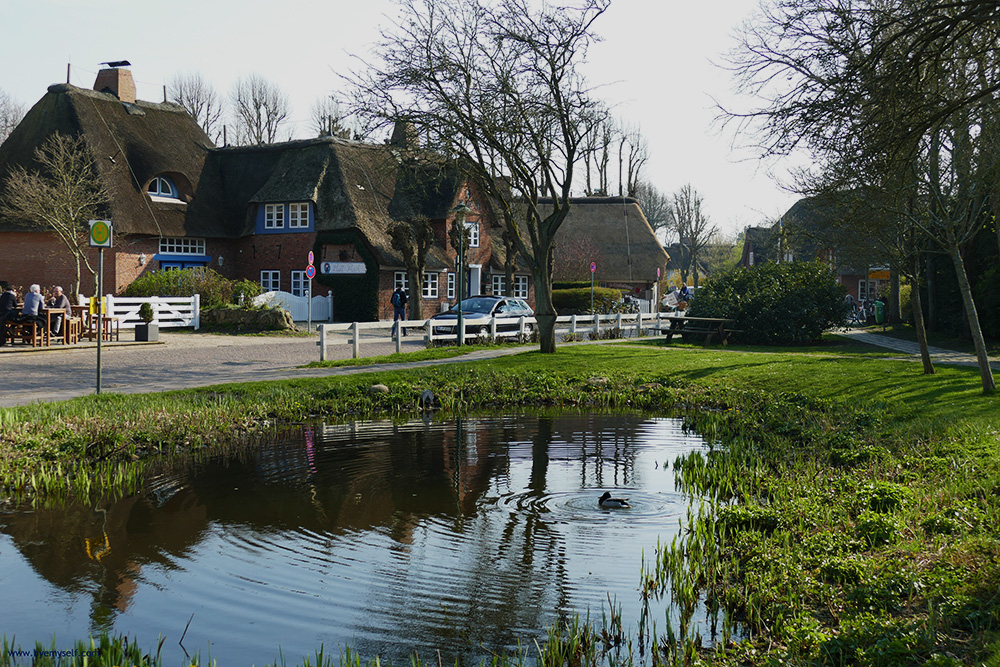
The cobblestone and pebblestone covered alleys are lined by linden trees, and roses in many colors are blooming in the gardens and on house walls.

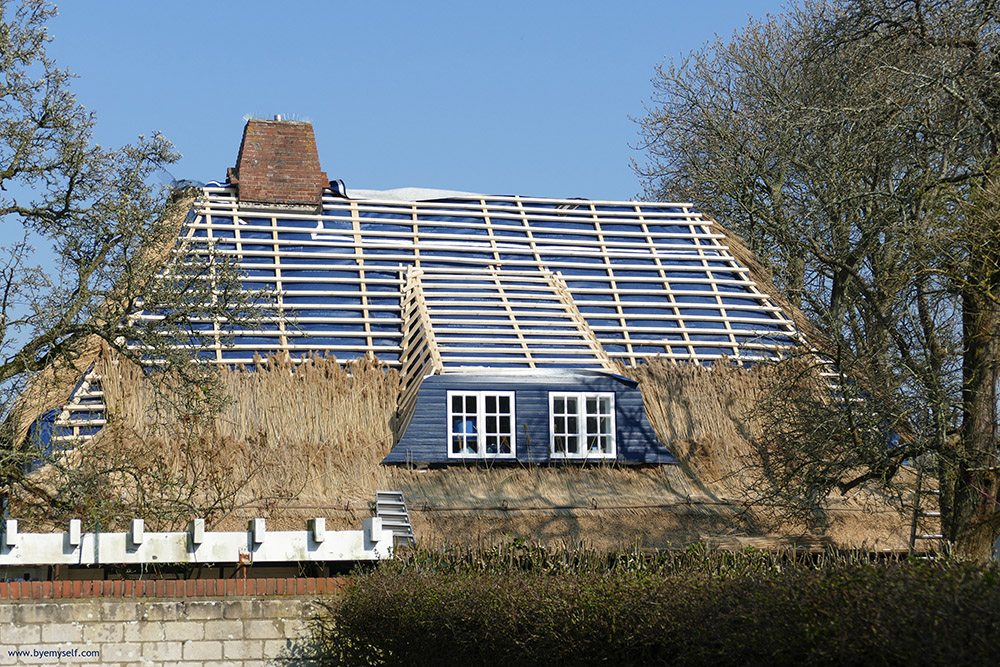
Just like Süderende, Nieblum’s center, too, is dominated by a house of worship, the Saint John church, called the Frisian Cathedral. It is Föhr’s largest church, built almost 600 years ago.
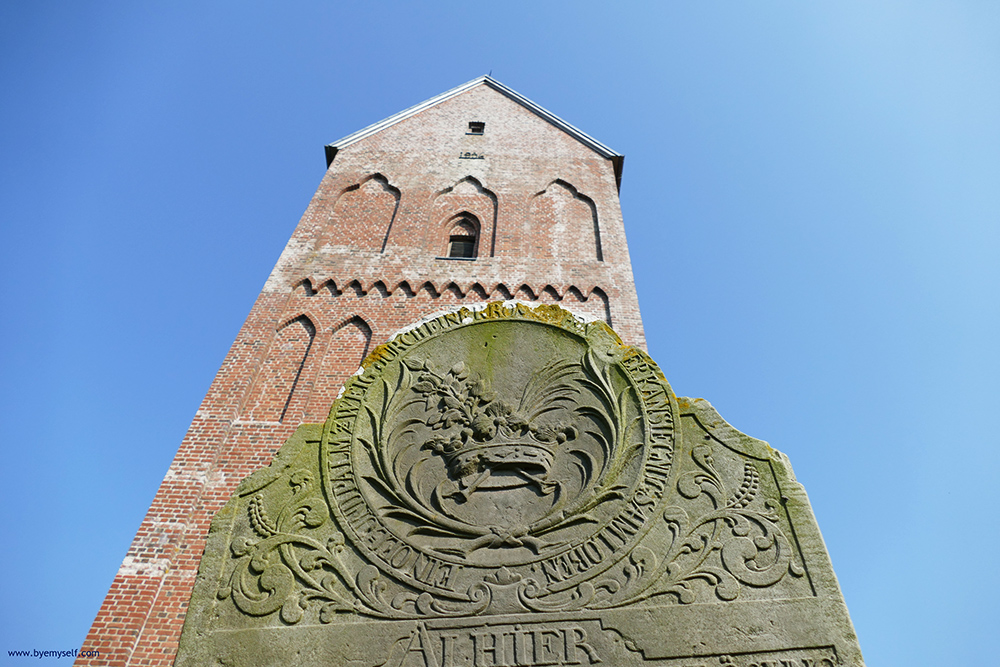
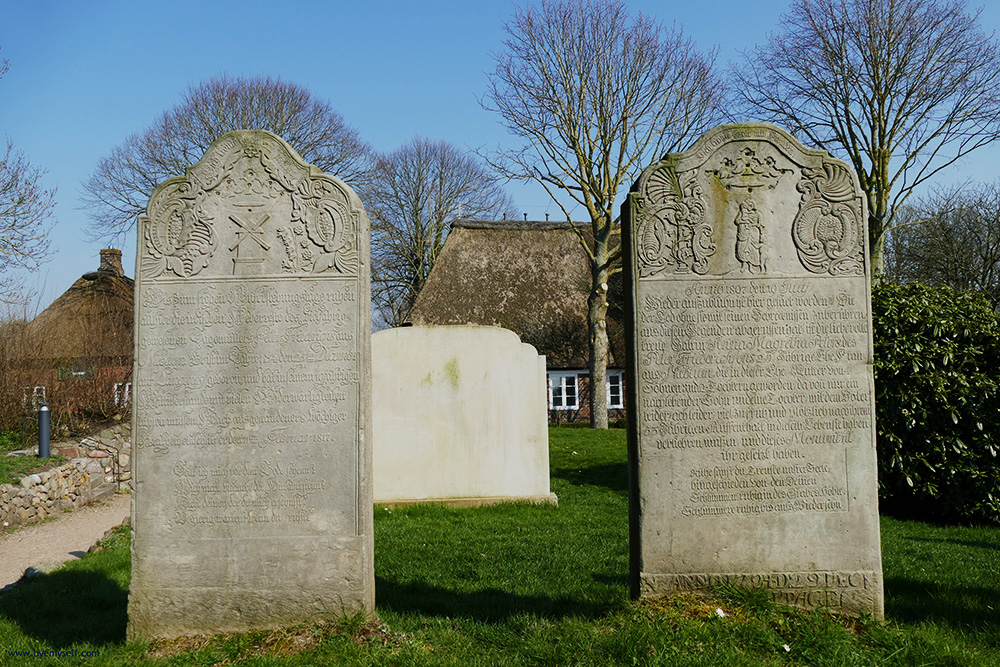
Practical Information
Getting There…
Although Föhr does have an airport and there are regular flights to the island from Sylt as well as from Flensburg and Husum on the mainland, most visitors are coming by ferry via the port of Dagebüll.
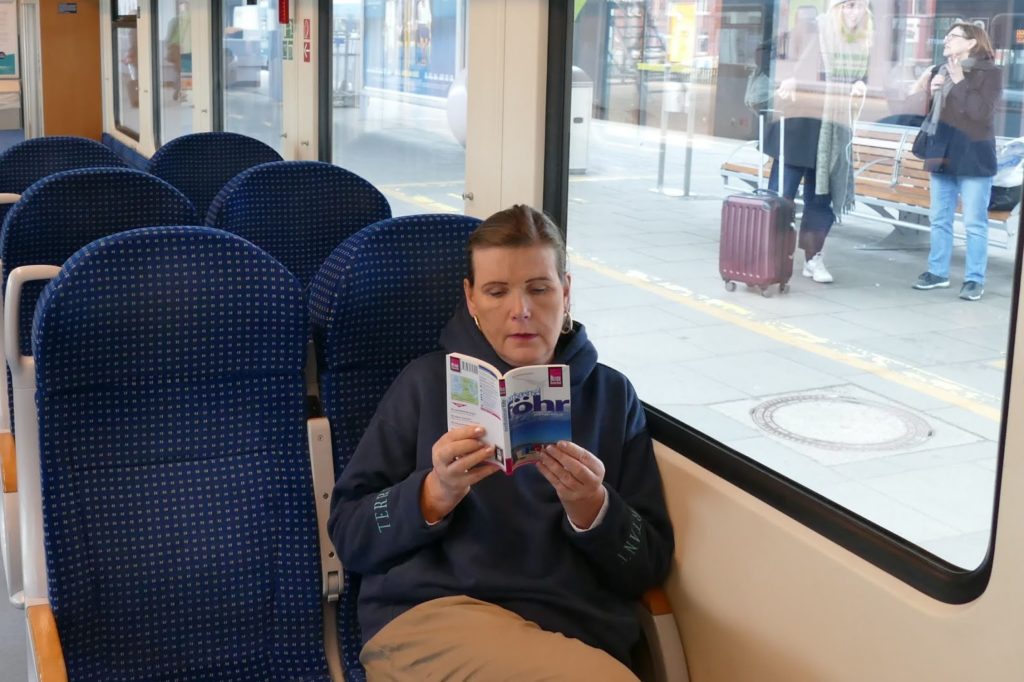
It’s not complicated to get from Hamburg to Föhr, however, it does take about five hours in total since you have to change trains and then wait for the ferry. But it’s definitely worth the small effort.
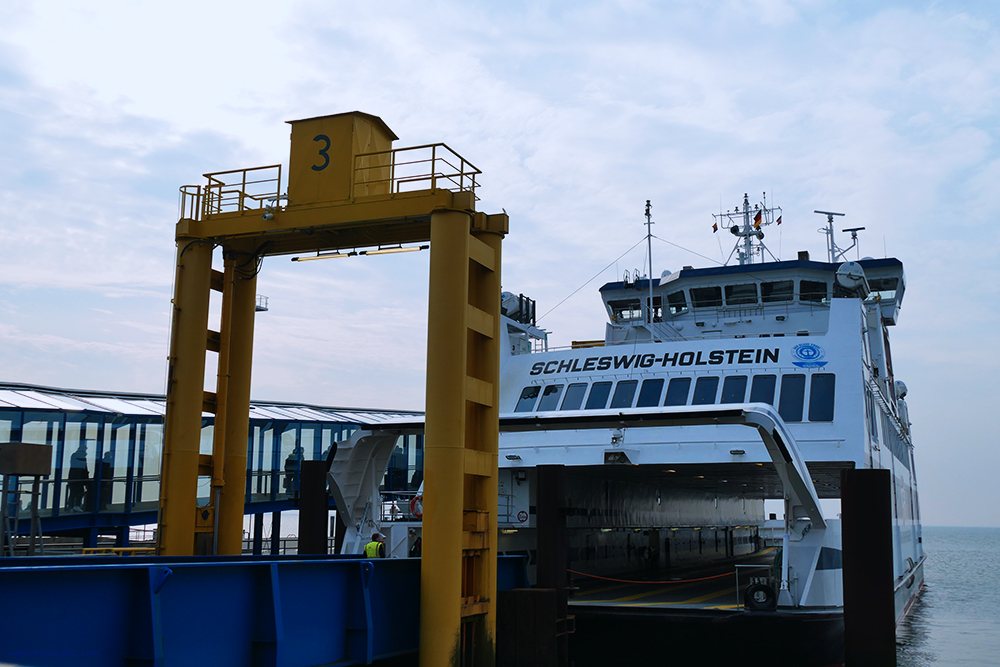
If you are coming from Hamburg or any place within the federal states of Schleswig-Holstein or Mecklenburg-Western Pomerania and you are not travelling by yourself, you might consider getting a so-called Schleswig-Holstein-Ticket. It costs 29 €uros for one person, and you have to add another 3 €uros per person travelling with you. So if you are two adults, it will set you back 32 €uros for both of you, if you travel with four other people, you’ll pay 41 €uros for your party of five; not bad, right? A child under 15 travels for free with two adults.

While you can actually travel the entire day within the respective federal state, you are only allowed to take the regional trains. These train numbers begin with RE, MET, etc. Keep in mind that you cannot take the interregional trains such as the Intercity (IC) or Intercity-Express (ICE).
For connections and rates, please visit the Deutsche Bahn’s website, it is available in seven languages.
The Germany Ticket for 58 €uros
Following the fantastic 9 €uro ticket that allowed nationwide travel for an entire month from June to August 2022, there is now the 58 €uro ticket. For good.
With the 58 €uros ticket, you can travel basically the entire country by regional trains. Those train numbers begin with RE, MET, etc. But remember, it is not valid in interregional trains such as the Intercity (IC) or Intercity-Express (ICE). However, you can also use regular buses, trams, subways, and suburban trains, as well as regional express trains everywhere in Germany.
While the 58 €uro ticket is valid throughout the country, it is not linked to German citizenship. It can also be purchased by non-residents. Although it is an annual subscription, it can be canceled on a monthly basis.
Once you get to the port of Dagebüll, you have to take the ferry. It crosses by the hour between 5 a.m. and 8 p.m. The last ferry from Wyk back to the mainland leaves already at 6.40 p.m.
The fare is 8,40 €uros one way and 13,60 €uros round trip for adults and 4,20 respectively 6,80 €uros for kids from 6 to 14 years old.
…and Around
The best way to explore the island is definitely by bicycle. Due to the harsh wind, I highly recommend renting an e-bike.
There is very little traffic on the island, and usually, people are driving pretty prudently when they see you. So make sure they do. Wear something flashy, turn on the light if necessary, and try to make way when cycling on the road.

However, if you are not into cycling, there are two public buses serving the entire island: Number 1 respectively 11 that go around the island on the northern route, getting to the villages practically in the order of this post. Bus Number 2, respectively 22, goes the other way around.
There are further buses at the center of Wyk.
Obviously, you can also explore the island by driving. But to me, it does not match the serenity, closeness to nature, and spirit of this beautiful island.
Money
On Föhr you are paying with €uro, obviously. Not every business takes credit cards, but there are various ATMs at Wyk, but also at Nieblum, Oldsum, and Utersum, so getting cash shouldn’t be a problem.
The exchange rate is 1 US$ = 0.85 €UR as of July 2025, but you can check the conversion on this page.
Language
I’d say that most people in Germany have at least a rudimentary knowledge of the English language, many even speak it pretty decently. However, this is neither Berlin nor Hamburg, and they cater mainly to national visitors, so don’t expect everyone to be fluent.
For some useful words and phrases, you might want to practice a little with help from e. g. Babbel. The first lesson is for free and already supplies you with useful basic vocabulary.
*Note: In this article, I’m writing out some of the German names and places, and you will notice that there are letters that might not exist in other languages. Most importantly for this article, there is the letter ö being pronounced more or less like the u in fur – which actually is very close to how you pronounce the island’s name.
Then there are also the vowels ä, which is very easy since it’s pronounced like an open e as in head, and ü that is pronounced approximately like the u in huge.
The letter ß, which exists only in the German alphabet, is by no means a B . It’s just like the double S as in kiss. When writing, you can actually replace it with a double S.
Tourist Info
After having read this post down to here, do you still need further information or have specific questions? Of course, I’m here for you, but more importantly, so are the friendly and knowledgeable people at the Tourist Information.
You can check their informative website or get your info in person at
Föhr Tourismus GmbH
Feldstraße 36
25938 Wyk
Phone: + 49 – 4681 – 30-0
Email: urlaub@foehr.de
Map
On this map, you get an overview of the island and can see where all the wonderful places that I’m recommending are to be found. Clicking on the slider symbol at the top left or the full-screen icon at the top right will display the whole map, including the legend.
This is the second post of a series on five absolutely fascinating islands in North Germany. I hope you’ve enjoyed it. Did it make you curious for more? Then make sure to check out these posts on the other great isles:
Pinnable Pictures
If you choose to pin this post, please use one of these pictures:

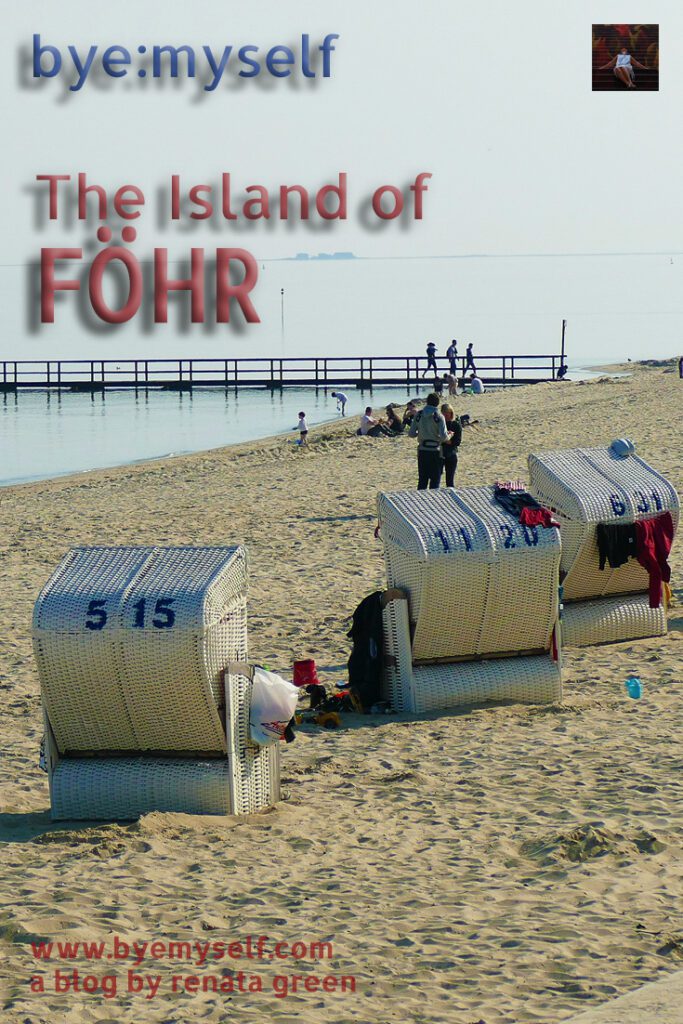
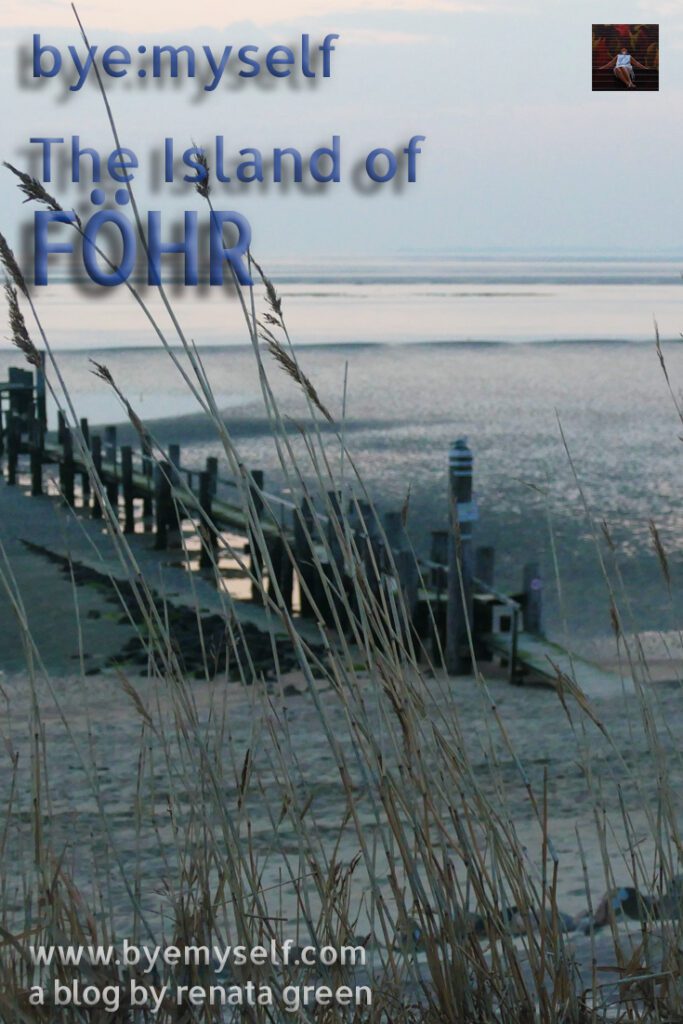
Note: I am completing, editing, and updating this post regularly – last in July 2025.
Did You Enjoy This Post? Then You Might Also Like These:
Best Street Art in FRANKFURT
CUXHAVEN – walking on water
FRIEDRICHSTADT – A Little Piece of Holland in Northern Germany
An Audience With the Queen
A Visit to the Berlin Biennale 2022
Guide to the Island of FOEHR – every village a home
Guide to the Island of BORKUM – West of East Frisia
Best Street Art in BERLIN
Disclaimer: I appreciate that Föhr Tourismus was supporting my blogger trip by supplying us with e-bikes, booking a room at the B&B Die Friesin and granting access to some attractions. However, all opinions on these services are mine and weren’t by any means influenced by my cooperation partner.
* This is an affiliate link. If you book through this page, not only do you get the best deal. I also get a small commission that helps me run this blog. Thank you so much for supporting me!
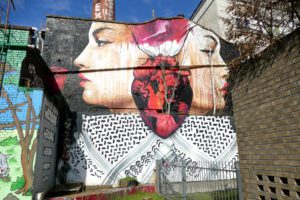
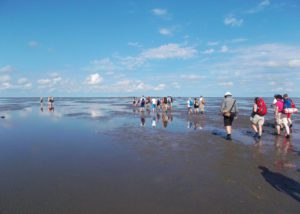
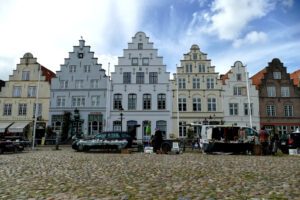


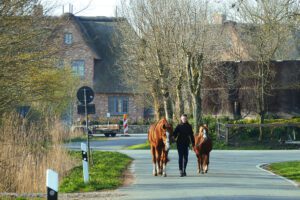
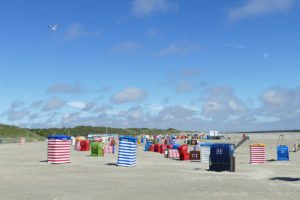

Thanks Renata for your inspirational “Guide to the Island of FOEHR – every village a home”.
I just retired and am (finally) planning to start my ‘Bucket List’, which always did include the Island of FOEHR, since it is the place of inception of my Paternal side of the family! I plan to stay at a particular Hotel which (apparently) includes our last name… Your work has inspired me to move this destination up on the list…. Our family has done some research, but none have actually returned/visited since the time my Great Grandfather left for America! I can’t wait to experience the food, culture, flora and fauna, and to walk on the sandy beach of my ancestors… Great Work!
Thank you for your message, Greg! Only when I did research during my last visit to Föhr did I learn how many islanders have migrated to the US. They even named an aperitif in their honor! Föhr is one of my favorite German islands, and I’m sure you won’t be disappointed! All the best – and happy retirement (I cannot wait myself 😉 )!
Quick question – is a guide absolutely necessary for the mud walking to Amrum and to the Sylt/seals? If one knows at what time to go, is it ok to go alone?
As a matter of fact, I would always go with a local guide unless you are meandering close to the shores. The water can come back faster than expected and if you lose your way, you’re in deep sh….water.
I like what you are up to. Such smart work and reporting! Carry on the excellent work! I¦ve incorporated you into my blogroll. I think it’ll improve the value of my site 🙂
Right, that’s it. Spring next year assuming life is fairly back to normal. I’m island hopping around Germany. I have found these posts fascinating. Are dogs allowed on the ferry?
Yes, they are. On the beaches, there are designated areas where they can go 😀
You had me convinced to visit this place with your first line – Föhr – every village a home. It is such a charming place for anyone wanting to visiting the coast. Like many I too love the wicker chairs and beds on the beach. I can laze of the whole day there.
How charming!! I love the wicker chairs and beds on the beach–I would stay there the whole time!! But if I ever actually got out, the whole area looks great and full of wonderful things to do!
This must be one of the most fascinating posts that I have read in recent times. The Island of Fohr is truely mesmerizing. The houses seem to belong to the pages of a fairy tale and are so cute. I liked the look of Wyk too and was enamoured by the thought of sleeping beneath the stars on the beach in a sleep wicker chair. A trip to Fohr seems like a journey into fantasyland.
Thank you so much for your kind comment! Yes, Föhr is definitely one of my favorite islands <3
There’s so much to love about Fohr. I had no idea it even existed. Such a treasure. The hooded wicker chairs are so neat and I love that you can spend the night in them. A dairy vending machine is so much better for you than a candy one. I love so much about this island. Next time I visit Germany, I will have to look into a visit there.
Hahaha, that’s right: It’s like healthy candy machine 😀
I can’t wait to read more in this series, I’ve learned so much from it already. Germany looks like a place I would love to visit.
What a charming community! I love that there is so much to do yet it feels like a small town! Adding it to my list!
What a fantastic place! I love discovering these gems and it looks like a place for self-reflection and peace. Thanks for sharing!
What a lovely place! Your pictures were so nice as well, they really showed amazing bits of the place.
This looks like a great place to visit! So remote from all the hustle and bustle
What a cute place! I love the wicker chairs, and the windmills!
Wow I’ve never heard of this island. I love going to unique spots so this will definitely be added to my list! I can’t wait to explore more parts of Germany 🙂
Didn’t know about this place until I read your post and so happy I came across this! What a charming place! Loved those beach baskets and those sleeping wicker chairs! I would spend most of my time there haha and also recline it to the maximum just like you! That’s the only best way to enjoy those chairs 😉
I am definitely adding this place and these experiences on my list!
I had read about Fohr’s past. It was a casual read but I liked reading about it. I never imagined that this place will be so peaceful.
What a fantastic place. I loved reading about it. Hopefully will visit someday.
Island of Fohr seems like such a beautiful place. I have never associated Germany with an island. This is definitely a hidden treasure and you have presented it so beautifully that it entices you to visit this place.
I would never have thought there would be islands in Germany. Shows what I know lol. It would be fun to sleep in a Strandkorb for at least 1 night.
Wow, Fohr is oozing cute villages. As an Aussie it’s fascinating to learn about smaller island of countries that I’d otherwise have no idea about.
Wow I have never been to Northern Germany and would love to visit one day as it is so different from where my relatives all live in Bayern! Looks so beautiful on the islands and very different from other parts of the country 🙂
Island of Fohr looks very unique due to so many types of houses and natural beauty here. First of all, I love those colorful wicker chairs at Nieblum and Wyk as they really look unique and have shed too. The town of Wyk really looks stunning with beautiful houses and greenery all around.
When most people think of islands, Germany doesn’t pop into mind generally. As someone who has traveled extensively in Germany I can agree with you that each is a hidden treasure with fantastic gems along the way. I love the Strandkorb sleeping baskets where you can sleep right on the beach! This is so cool! Thanks for the really great and informative article!
Föhr looks absolutely beautiful! I love the hooded wicker chairs on the beach!
Eve x
I wish it was safe to travel because this is giving me a serious travel bug.
Thanks so much for sharing! I loved seeing Fohr through your eyes – great pics! 🙂
I’m all for sleeping in a wicker basket chair at Fohr. Plus those windmills are fascinating to me. Thank you for sharing the coastline of Germany–like many others, I had no idea there were so many interesting places to visit.
Great comprehensive article. I had never heard about this island before, although been to Germany a number of times. I now so want to visit 🙂
Your articles alway give a very good insight into places we never knew existed. This is a beautiful island worth visiting.
What an off the beaten path gem! Surprisingly interesting part of Europe it would never cross my mind to see. Thank you for the pronunciation lessons, I learned so much!
Very elaborate and informative post ! I would love to cycle around such a beautiful place also sleepin on the beach sounds exciting.
I’ve never heard of Föhr but I wish I had known of this cute little island when I went to Hamburg, I’ll have to make my way back to Germany again 😉
Beautiful! What a unique area of the world and I love the wicker chairs!
Wow, I love how you captured the beauty of the island and its cozy ambiance. The Frisian houses look so amazing! I will definitely add this in my bucket list once we can travel safely again. Thank you!
I love traditional arhitecture; and to sleep in a wicker chair, on the beach, by yourself, sounds like a challenge to me!
Such a charming island. I would love to spend a day on the beach in one of those iconic Strandkorbs as well as stroll around the villages and admire the local architecture. Germany is definitely a country of hidden gems 🙂
That’s true, most foreigners don’t know how many interesting and quirky places there are in Germany.
Those wicker chairs that convert to an overnight bed on the beach are inspired. What a great way to enjoy a night under the stars. They look like a throw back to a different era.
I so regret that we were there in April when it was still too cold to sleep outside. I absolutely need to do that one day ?
I never knew Germany has such beautiful islands! I would definitely take the train even if I have to change a couple of times. Thank you for introducing the island of Fohr.
NICE PEOPLE AND ISLAND. I WAS THERE IN A HOBBIE CAT WORLDCHAMPIONSHIP HELD IN FOHR.
All these villages are so pretty and they have interesting names too. We too prefer countryside much more than cities. The beach basket is actually my favorite. It will be fun spending a night in it among the stars.
Wow! This was a great post. Now I definitely want to go visit!
Island of Fohr is new to me and really loving it from your description. I loved the look of the cottages. The modern buildings look so ug comparatively.
Thank you, glad you like it. Yes, they have the beaches and the sea and the endless fields and the yummy Frisian cake – but the thatched buildings are Föhr's strongest suit to me.
Why such a boring video when foehr has so much to offer, we don't just accomandate for over 80's.
I have no clue what 'video' you are talking about.
However, I agree that Föhr has a lot to offer and if you are missing something in my post, I'd appreciate you add it in the comments so that everybody can learn from your experience.
I have not heard of the island of Fohr before but I can see why it is such a popular holiday spot. Such a beautiful place to go in Germany.
Yes, it's really special and in a perfect location.
I had never heard about this place before So, thank you for introducing Fohr to me. Beach looks beautiful. It seems like a peaceful place without huge influx of tourist. Hope to stay there for at least couple of days when I go to Germany.
It's a great place to get away from all the hustle and bustle at the big cities. Total serenity!
I appreciate the aesthetics of the cottages. Especially the roofs. Considering I am coming from Croatia, they look like rue fairytale cottages. It would be interesting to me to spend some summertime on the North Sea instead of the Adriatic Sea.
Yes, it's very beautiful – but so is Croatia. I spent last summer there and fell in deep love with the country. We could swap houses for the summer 😉
The cottages are so picturesque! I love the beach photos and the beach chairs with a cover. This looks like a great spot to spend some time slowing down and relaxing
Me too, I love these thatched houses. The beach chairs are my favorite: They are like tiny beach cabanas with footrests, little tables, space for your belongings – just perfect for a beach day.
Thanks for introducing Fohr to us. I never thought of islands when I thought of Germany. Thanks for the suggestion to take an eBike to explore the islands. This way we could stop regularly at the cute spots you have pointed out. Good do know that you recommend Nieblum as the prettiest of the small towns. A good stop after we have tried the beach at Utersum. Such a cute spot.
I know, most foreign visitors think of mountains and cruises on the river Mosel – and they miss out on so much when not visiting the northern coasts.
Such a great detailed post! I love the idea of the beach sleeping chair, I've never heard of those before, but they sound amazing, just imagine hearing the crash of the waves as you fall asleep!
I was all excited when I learned that they have these sleeping chairs. However, since we were there in April before the season has started, I have to go back to try them out – it must be amazing!
That's nice to get to know some islands in Germany and looks like you had a wonderful and relaxing holiday there! Thanks for the info and hopefully I will get to visit there myself next time! @ knycx journeying
We had a fantastic stay there – cycling between the fields, taking a break in a beach chair, more cycling, overlooking the sea…just soooo relaxing.
I never think of islands when I think of Germany! So cool! I would definitely stay in a Strandkorb, sounds delightful! Thanks for sharing.
Very few international visitors do – therefore, I'm reminding them 😉
Great places and tour. I loved those sleep wicker chairs on the beach.
I wasn't aware of the island of Fohr, though I knew about Wadden Sea. That's a list of beautiful places in your blog. I have been sold to the idea of spending at least 2 weeks there to explore all.
Actually, if you'd like to explore all the five islands I'll be introducing, that will be two weeks well spent 😉
Looks really cool the village. Do you think is good place to visit during summer?
It depends on what you like. Of course, in summer it's like the epitome of a beach vacation – however, in winter the Nordic islands have their very own charm.
Looks delightful. Very similar to Rømø just up the road in Denmark. kx
It will be of no surprise to you that the North Frisian islands actually used to be Danish. There is still a Danish minority living in the federal country of Schleswig-Holstein, speaking Danish and keeping up the traditions; and like you said: It's just up the road 😉
I have never heard of this place but it looks amazing! Adding it to my list!
Glad you like it: It's the best place if you are looking for a couple of days having the feeling of doing nothing – and still see and do a lot!